Let me start writing the article.Transitional dining rooms represent the perfect marriage between timeless traditional elegance and fresh contemporary appeal. This design approach integrates different eras and styles into modern design, creating spaces that feel organically evolved rather than assembled all at once. By balancing traditional and modern elements, transitional style offers the best of both worlds - sophisticated yet welcoming spaces. With neutral color schemes serving as a canvas for other design elements, these dining spaces convey soothing atmospheres while allowing flexibility in furniture choices and decorative accents. Whether you're hosting intimate family dinners or elegant dinner parties, these versatile spaces adapt beautifully to any occasion while maintaining their refined charm and comfortable functionality.
1. Classic Wooden Transitional Dining Table with Contemporary Details
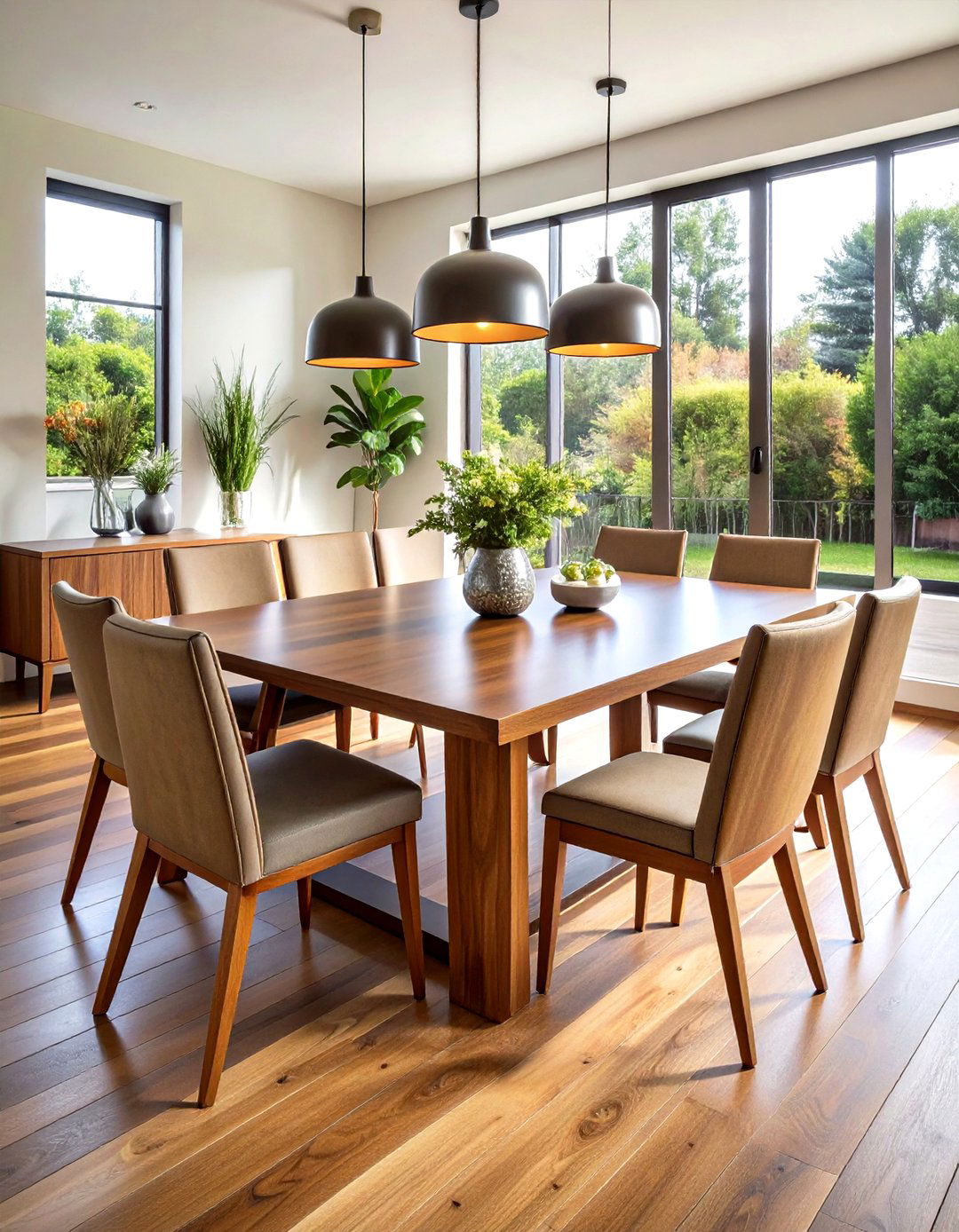
A gorgeous dining table should be the heart of your transitional dining room, with classic wooden tables paired with contemporary chairs creating timeless appeal. Choose rich wood tones like oak, walnut, or cherry that bring warmth and character to your space. Look for tables featuring subtle modern touches such as sleek metal legs, minimalist hardware, or clean-lined silhouettes that bridge traditional craftsmanship with contemporary aesthetics. Consider tables with removable leaves for versatility when hosting different sized gatherings. The natural grain patterns and warm undertones of quality wood create an inviting foundation that pairs beautifully with both upholstered and metal seating options, ensuring your transitional dining room feels both sophisticated and approachable.
2. Mix-and-Match Transitional Dining Room Seating Combinations
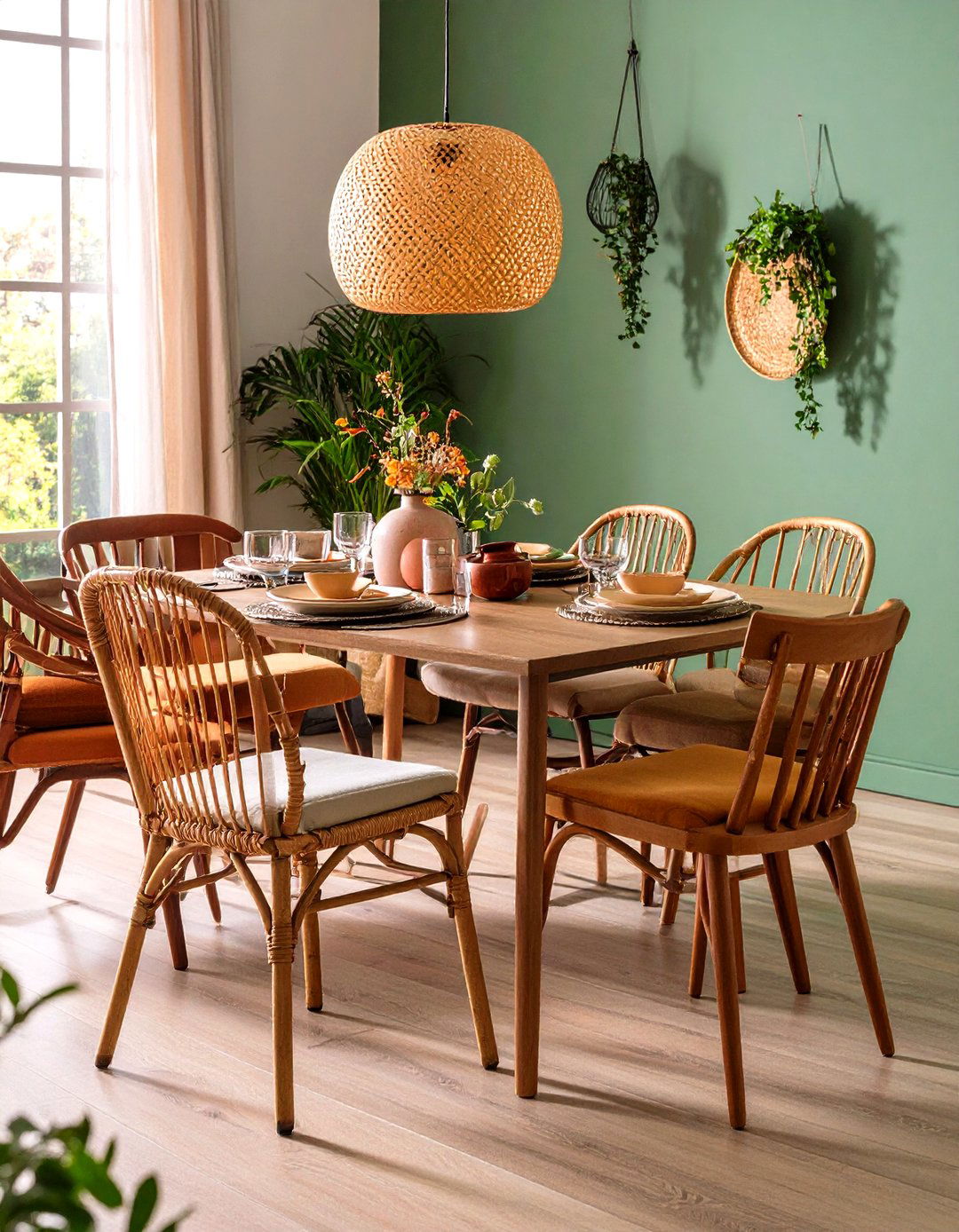
Transitional dining rooms are perfect spaces to try unexpected trends like mix-and-match dining chair looks, with rattan chairs and upholstered Parsons chairs creating interesting visual variety. This approach allows you to combine different textures, materials, and styles while maintaining cohesion through color or scale. Consider pairing two traditional upholstered host chairs at the table ends with sleek modern side chairs, or mixing wooden Windsor chairs with contemporary metal designs. Comfort is king in current dining trends, with ergonomically designed chairs featuring cushioned seats and supportive backs encouraging relaxation during meals. This strategy creates visual interest while ensuring every seat offers both style and functionality for extended dinner conversations.
3. Neutral Transitional Dining Room Color Palette Foundations
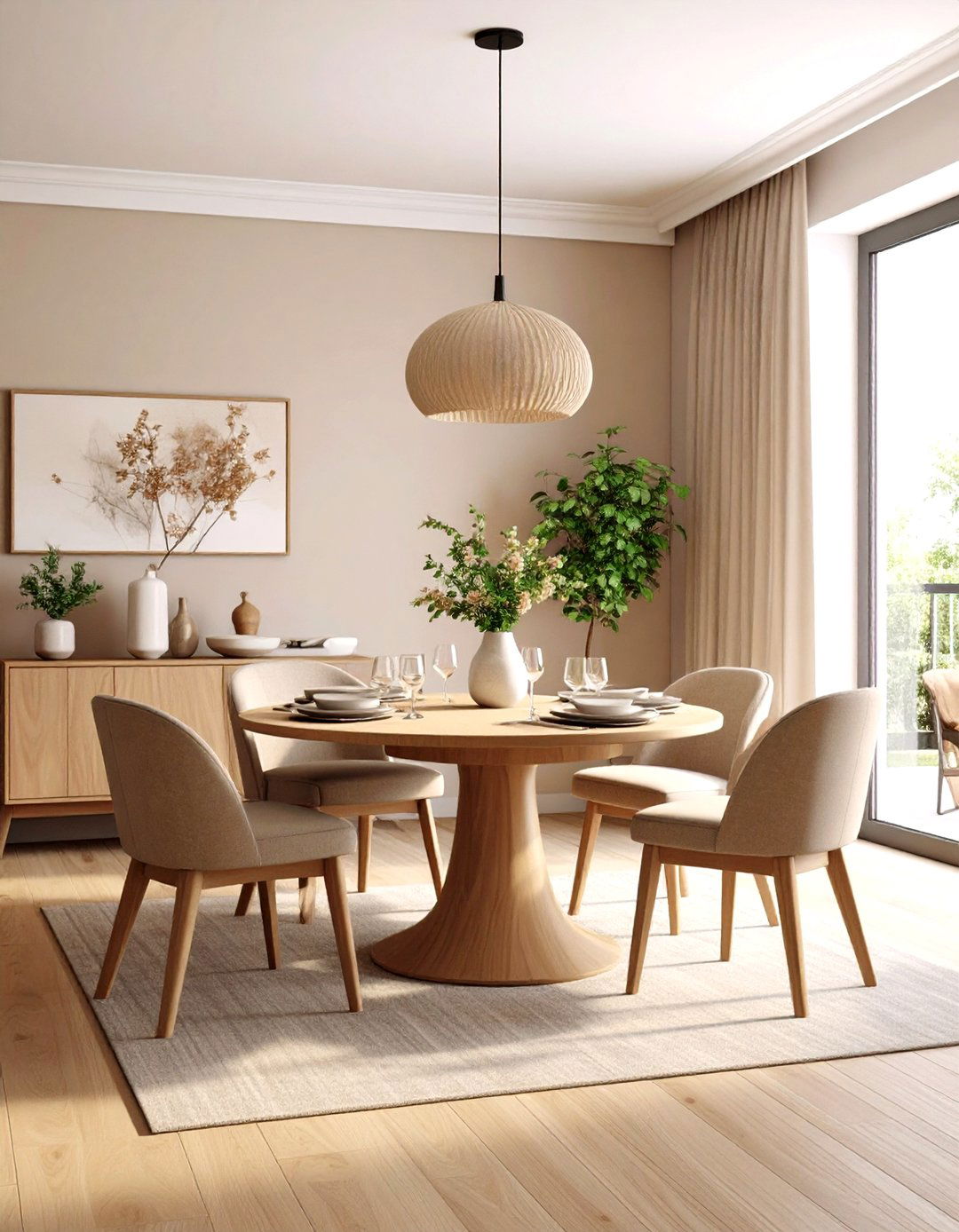
Transitional dining rooms commonly rely on neutral color schemes, with beige, gray, and soft tones like taupe serving as popular choices for walls and furnishings that convey soothing atmospheres. These foundational hues create versatile backdrops that allow furniture and artwork to shine while maintaining timeless appeal. Lighter shades allow for contrast and can be used from ceiling to floor or combined with crisp white woodwork for looks that feel both classic and current. Consider warm whites, soft creams, or sophisticated greiges that provide depth without overwhelming the space. These neutral foundations offer endless flexibility for seasonal decorating changes and allow you to incorporate colorful accessories, artwork, and table settings that reflect your personal style.
4. Statement Transitional Dining Room Chandelier Focal Points
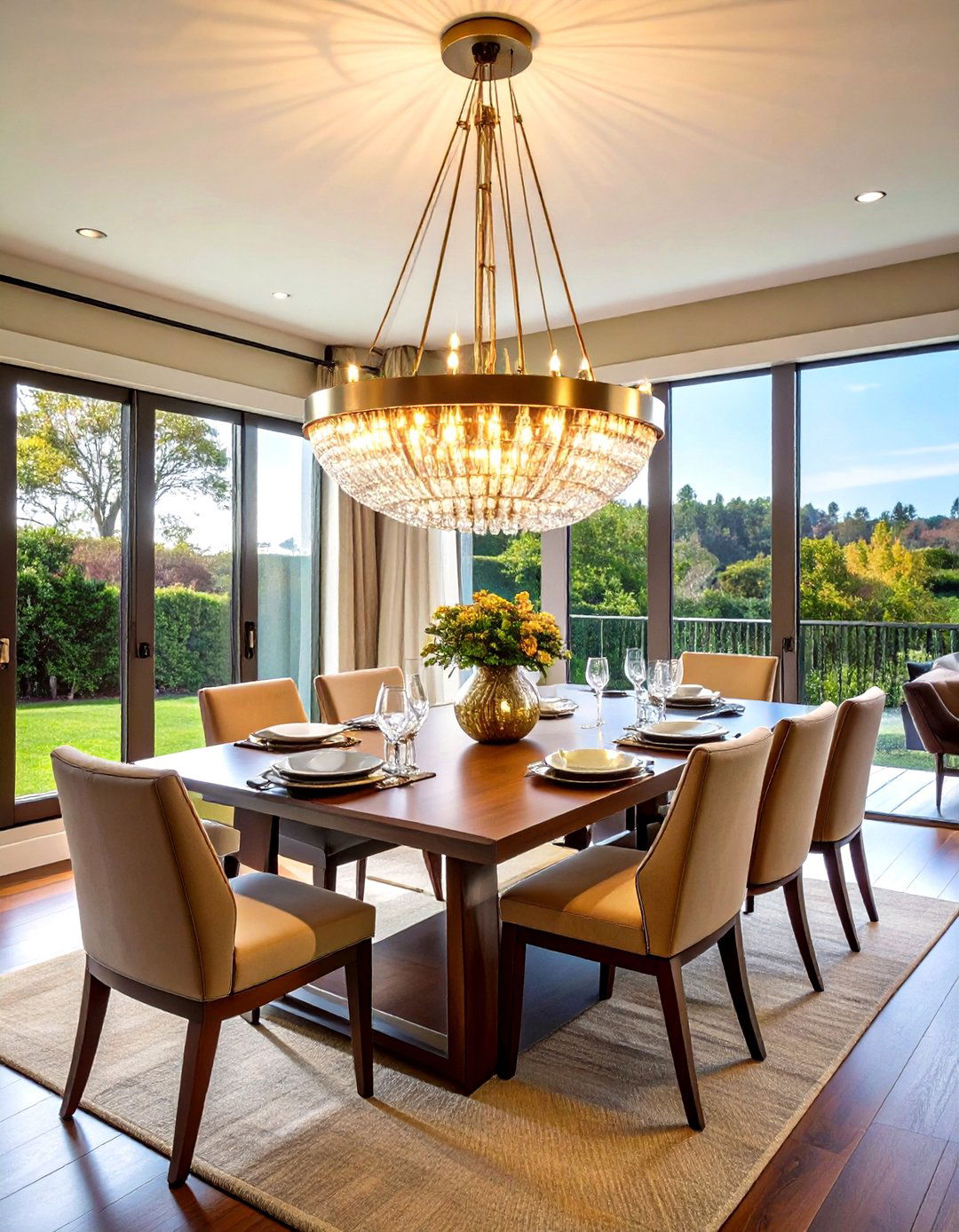
Transitional chandeliers marry classic lighting frame shapes like lanterns or candelabra styles but feature simpler curves and straight lines, mixing materials like brass, matte black iron, or bronze. Basic traditional chandeliers are outdated, with bold, unique lights trending that emphasize large scale designs, unique materials and contemporary shapes. Choose fixtures that blend ornate traditional elements with clean modern lines, such as crystal drum chandeliers or geometric metal designs with warm brass finishes. Hang your chandelier so its bottom sits 32 to 34 inches from the dining table surface for optimal lighting and visual proportion. These statement pieces become conversation starters while providing beautiful ambient lighting for intimate dinners and festive gatherings.
5. Functional Transitional Dining Room Storage Solutions

Adding buffet tables or sideboards helps maximize smaller dining tables by keeping food and serving pieces accessible while maintaining clear table surfaces for place settings and glassware. Choose pieces that blend traditional storage functionality with contemporary aesthetics, such as wooden sideboards with sleek metal hardware or modern credenzas with classic proportions. Look for pieces combining closed storage and open shelving to display favorite dishes or decorative items. These versatile storage solutions serve multiple purposes - hiding dining linens, china, and serving pieces while providing surfaces for decorative vignettes, seasonal displays, or additional serving space during entertaining. Quality storage pieces become investment furniture that grows with your decorating style.
6. Layered Transitional Dining Room Lighting Design
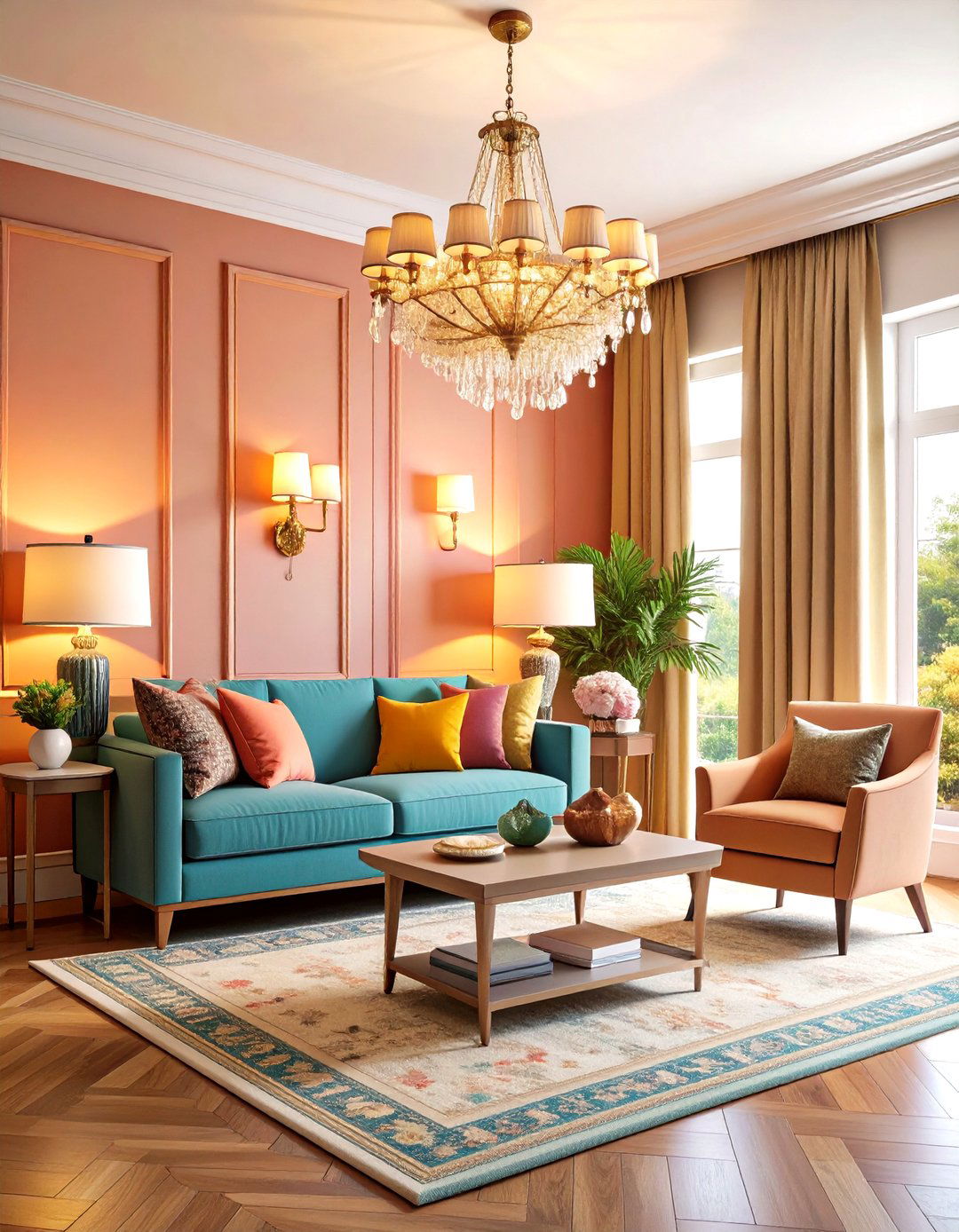
Besides your statement chandelier, creating layered lighting transforms your transitional dining room into a versatile space for various occasions. Layer a variety of fixtures for diversity, including table lamps that extend beyond functionality to become integral parts of decorative sideboard vignettes. Add wall sconces flanking a buffet or artwork to create warm ambient lighting, while table lamps on side surfaces provide intimate task lighting for reading or conversation. Sconces add elegance with accent lighting while enhancing the overall design aesthetic. Consider installing dimmer switches to adjust lighting intensity from bright family meals to romantic dinner settings. This thoughtful approach ensures your dining space adapts beautifully to different moods and functions.
7. Transitional Dining Room Area Rug Foundations
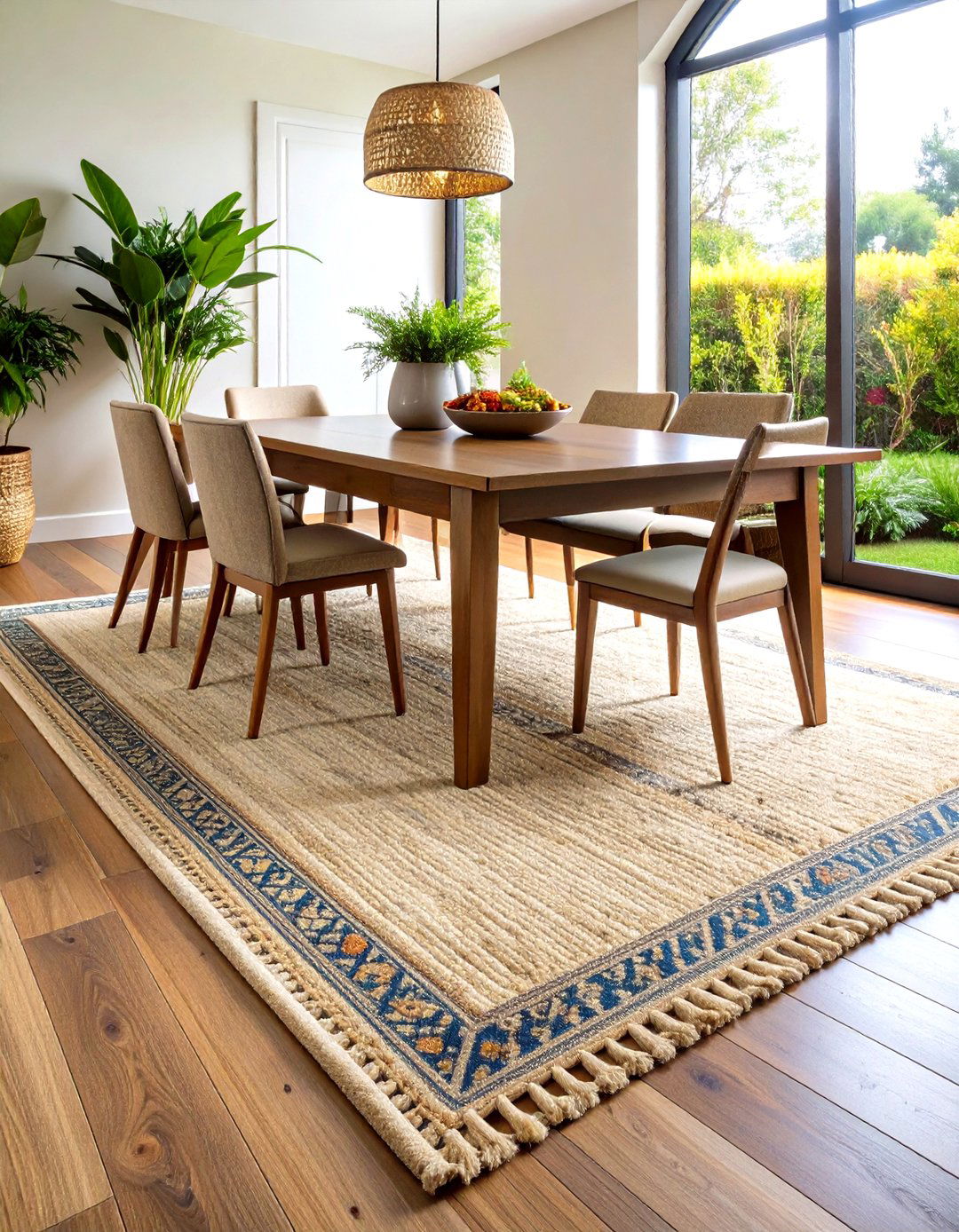
A luxurious area rug easily updates your dining room, with sizes large enough to accommodate table and chair legs ensuring both aesthetic appeal and safety as people move around the table. Choose rugs that ground your transitional dining room while adding texture and visual interest through subtle patterns or rich textures. Stick to neutral tones or soft, muted colors that complement your overall color scheme while ensuring the rug accommodates your table and chairs even when pulled out. Natural fiber rugs like jute or sisal offer durability and texture, while low-pile options make cleaning easier after meals. Textured rugs bring wonderful dimension to spaces without overwhelming the overall design. The right rug creates a defined dining zone while protecting floors and reducing noise.
8. Architectural Transitional Dining Room Wall Treatments
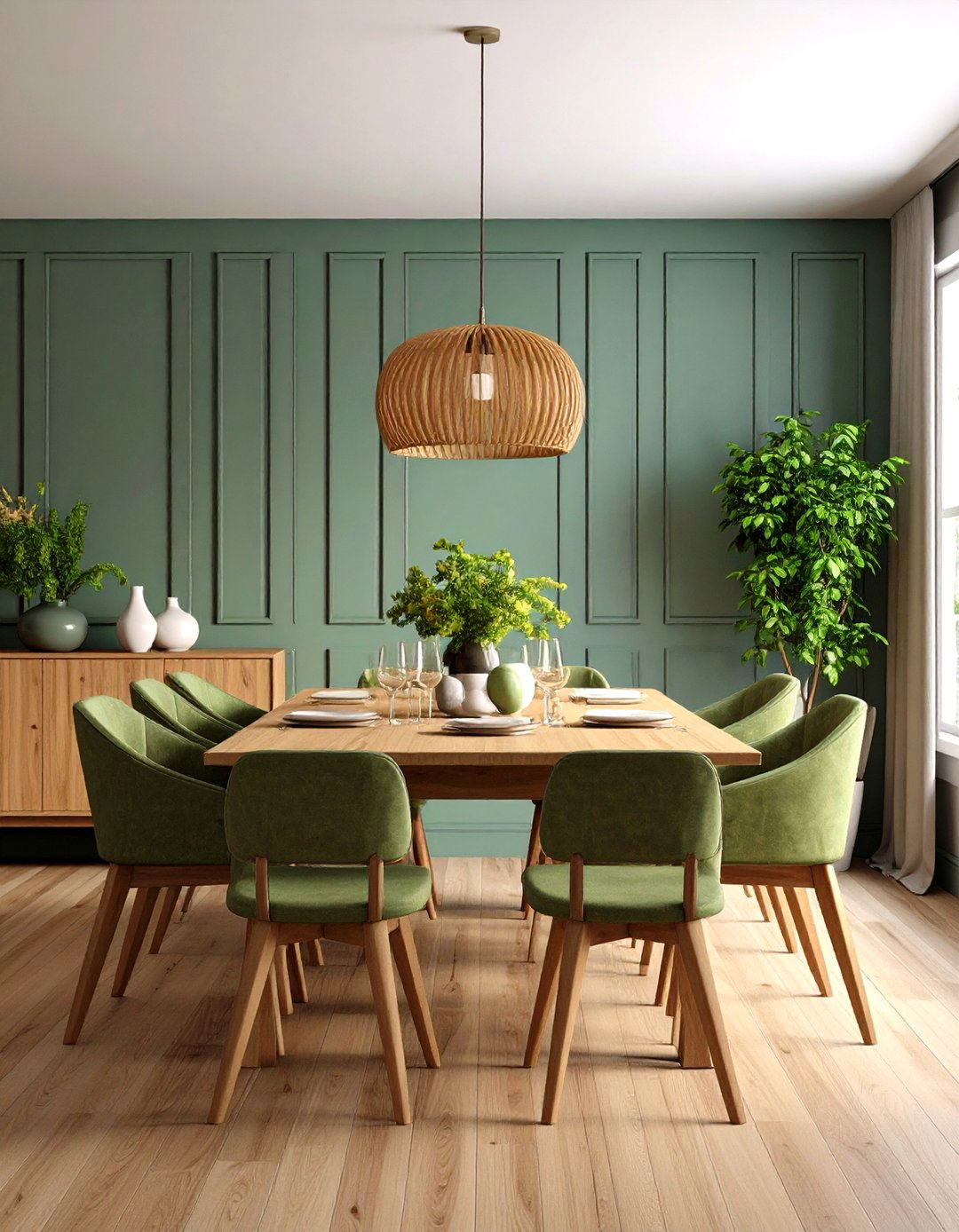
Landscape murals in dining rooms are becoming a major trend, with dramatic wall treatments adding personality and depth to create true design moments. Consider sophisticated wall treatments that bridge traditional and contemporary aesthetics, such as board-and-batten wainscoting painted in crisp white with walls in deeper neutral tones above. Lime wash paint techniques create beautiful textural backgrounds that complement both traditional architecture and modern furnishings. Deep chocolate, eggplant, and teal green walls are trending for dining rooms, with lacquer finishes adding eternal glamour and seductive reflective qualities. These architectural elements add visual interest and sophistication while maintaining the balanced aesthetic that defines transitional style.
9. Natural Material Transitional Dining Room Elements
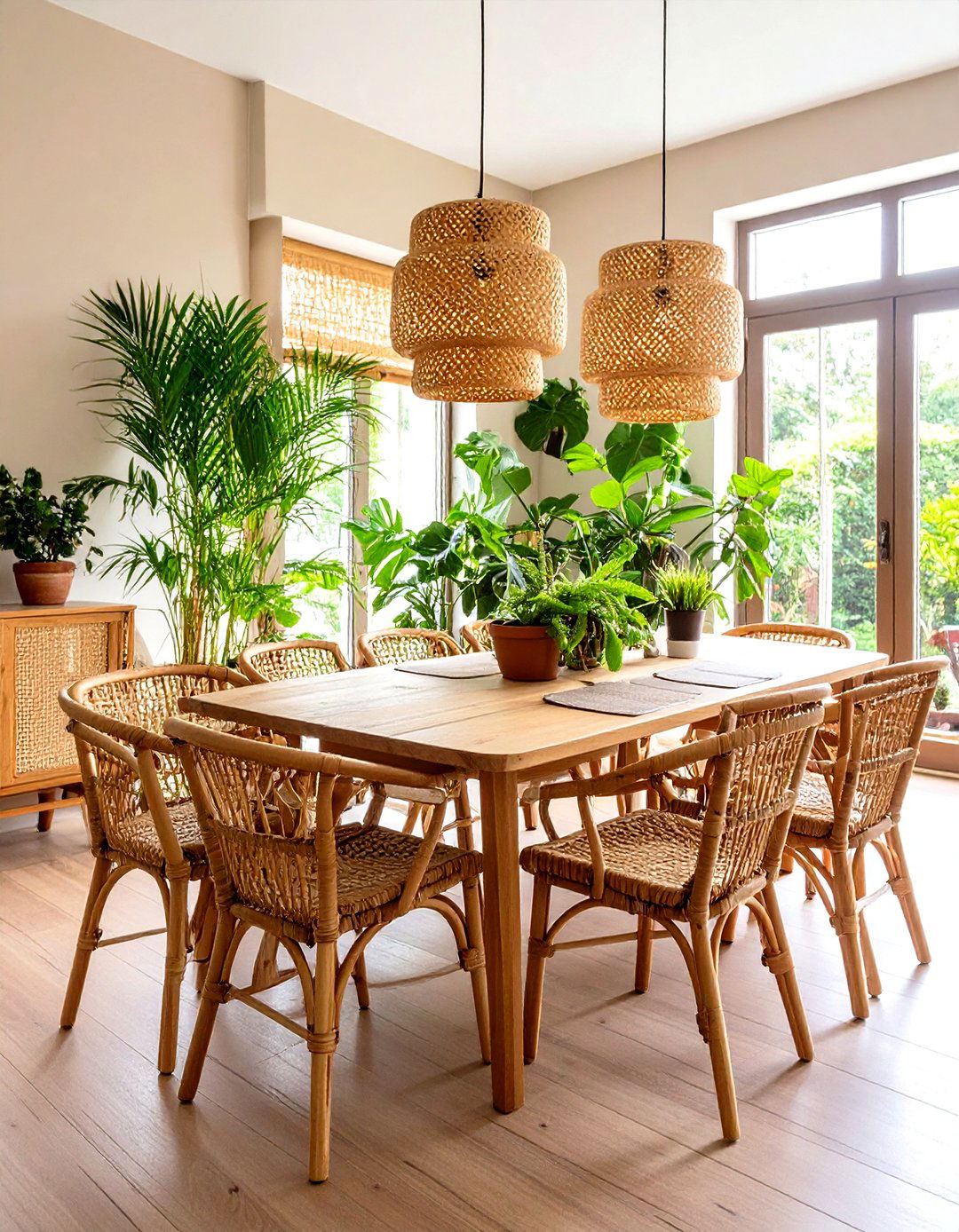
Incorporating natural materials and greenery continues the trend of bringing outdoors inside, with wood tables, woven seating, and potted plants creating serene environments. Integrate organic textures through rattan dining chairs, natural wood furniture with visible grain patterns, and woven accessories that add warmth and character. Consider incorporating live plants in attractive planters, natural fiber window treatments, or wooden serving pieces that emphasize the connection to nature. Mixing natural materials like hand-wrapped rattan frames with brass accents creates sophisticated, textural looks. These elements soften the formality of dining spaces while maintaining the sophisticated balance essential to transitional design, creating environments that feel both refined and relaxed.
10. Transitional Dining Room Gallery Wall Arrangements
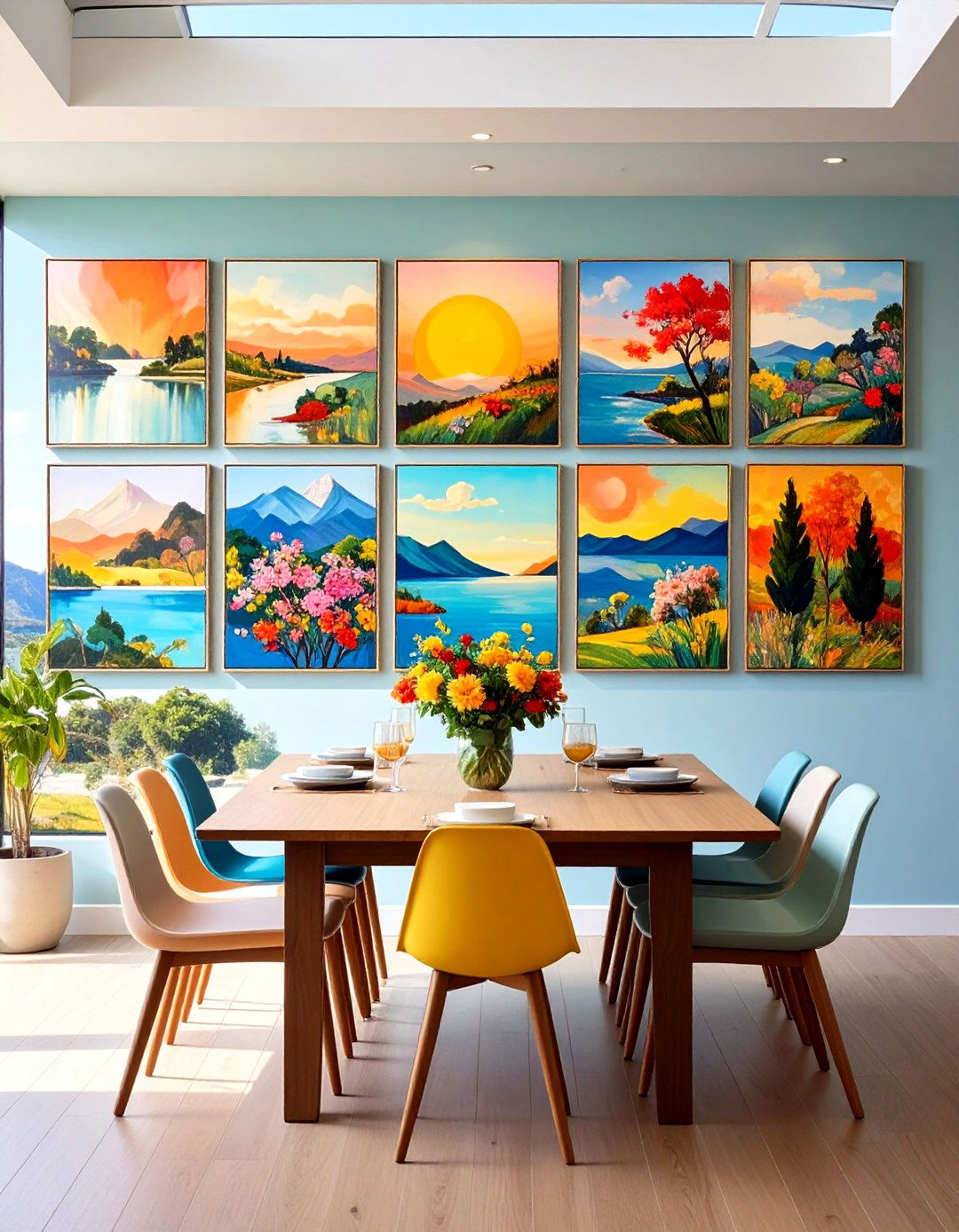
Adding oversized landscape or abstract artwork instantly adds visual interest, with pieces easily swapped seasonally to accommodate trending styles. Create curated gallery walls that showcase your personal style while maintaining the balanced proportions essential to transitional design. Mix frame styles and artwork scales, combining traditional landscape paintings with contemporary abstract pieces or photography. Large mirrors enhance the sense of space and promote natural light flow while paired with table lamps and sideboard centerpieces for clean, refined looks. Gallery walls serve as easy conversation starters during meals while reflecting your personality and interests. The key lies in maintaining visual balance through consistent spacing, complementary color palettes, and varied but harmonious frame styles.
11. Transitional Dining Room Open Concept Integration
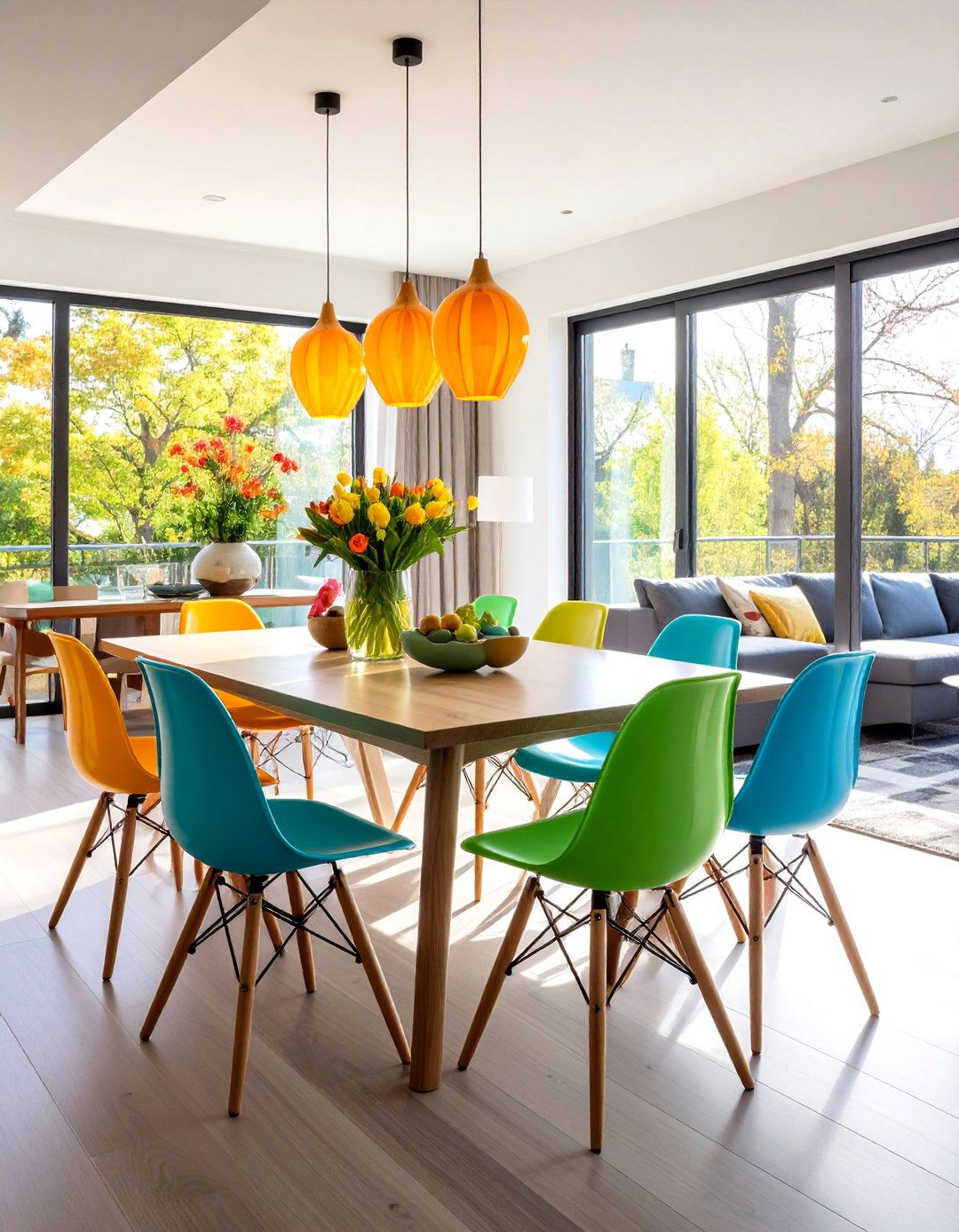
Dining spaces are being carved out closer to living rooms for family-friendly, casual lifestyles, using timeless furniture pieces like Saarinen Tulip tables or Louis Ghost chairs to create seamless transitions. Design your transitional dining area to flow naturally with adjacent kitchen and living spaces through consistent color palettes, similar design aesthetics, and strategic furniture placement. Consider colors that create seamless transitions between different areas, with shades that relate to neighboring spaces for better visual flow. Use area rugs, lighting, or furniture arrangement to define the dining zone without creating hard barriers. This approach maximizes functionality while maintaining the sophisticated, cohesive aesthetic that makes transitional design so appealing for modern living.
12. Sophisticated Transitional Dining Room Window Treatments
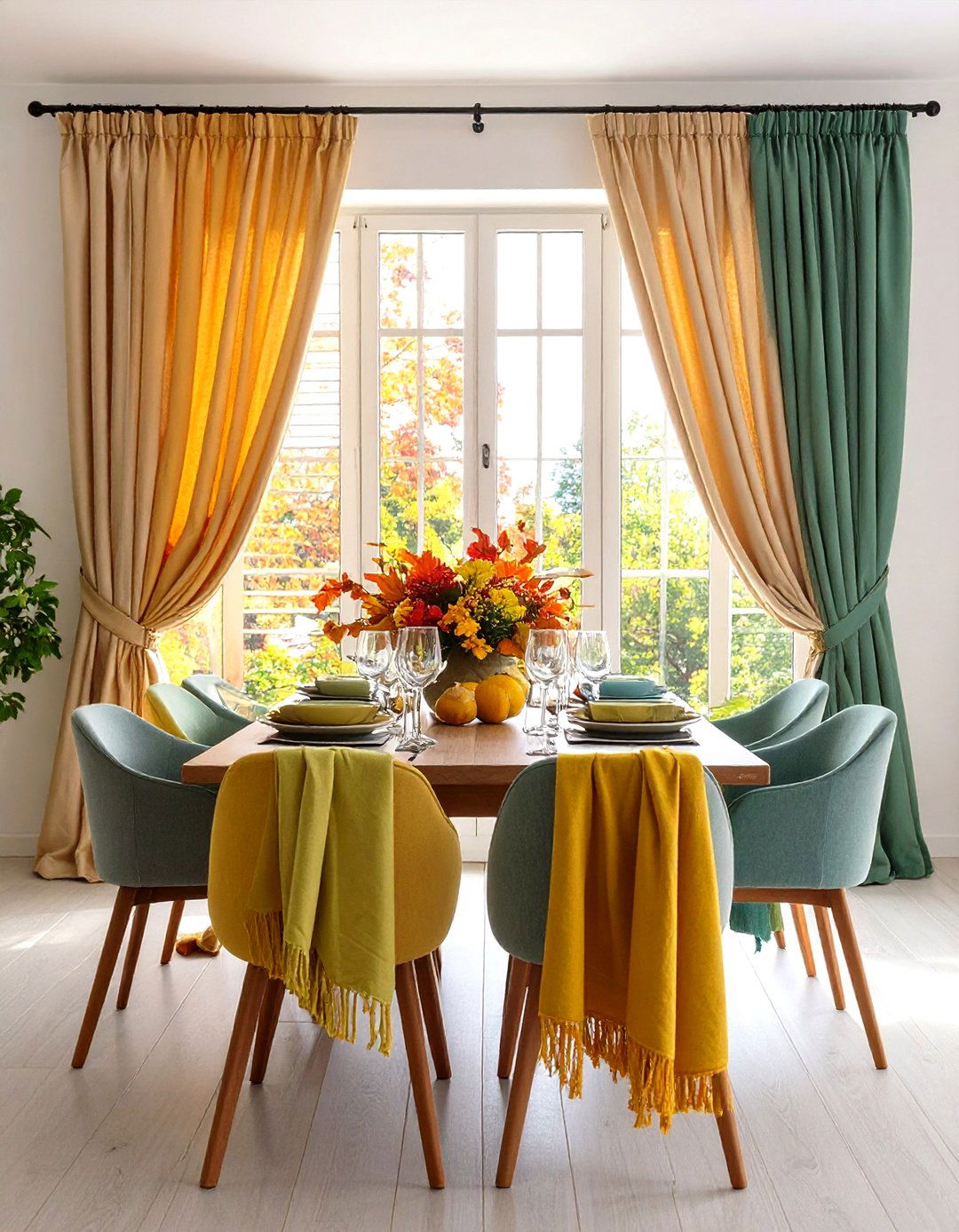
Choose window treatments that balance privacy needs with natural light while complementing your transitional dining room's refined aesthetic. Consider layered approaches combining functional blinds or shades with decorative panels in natural fabrics like linen or cotton. Natural textures and warm undertones create cozy, inviting environments that feel fresh in spring and summer. Select neutral colors that coordinate with your wall palette while adding subtle texture through fabric choice or pleating styles. Avoid overly ornate treatments that compete with your chandelier or artwork, instead choosing clean-lined options that frame views beautifully. Don't block beautiful views with heavy curtains or excessive furniture, allowing natural light to flow into the space. Well-chosen window treatments enhance privacy while maintaining the bright, airy feeling essential to transitional style.
13. Warm Metallic Transitional Dining Room Accents
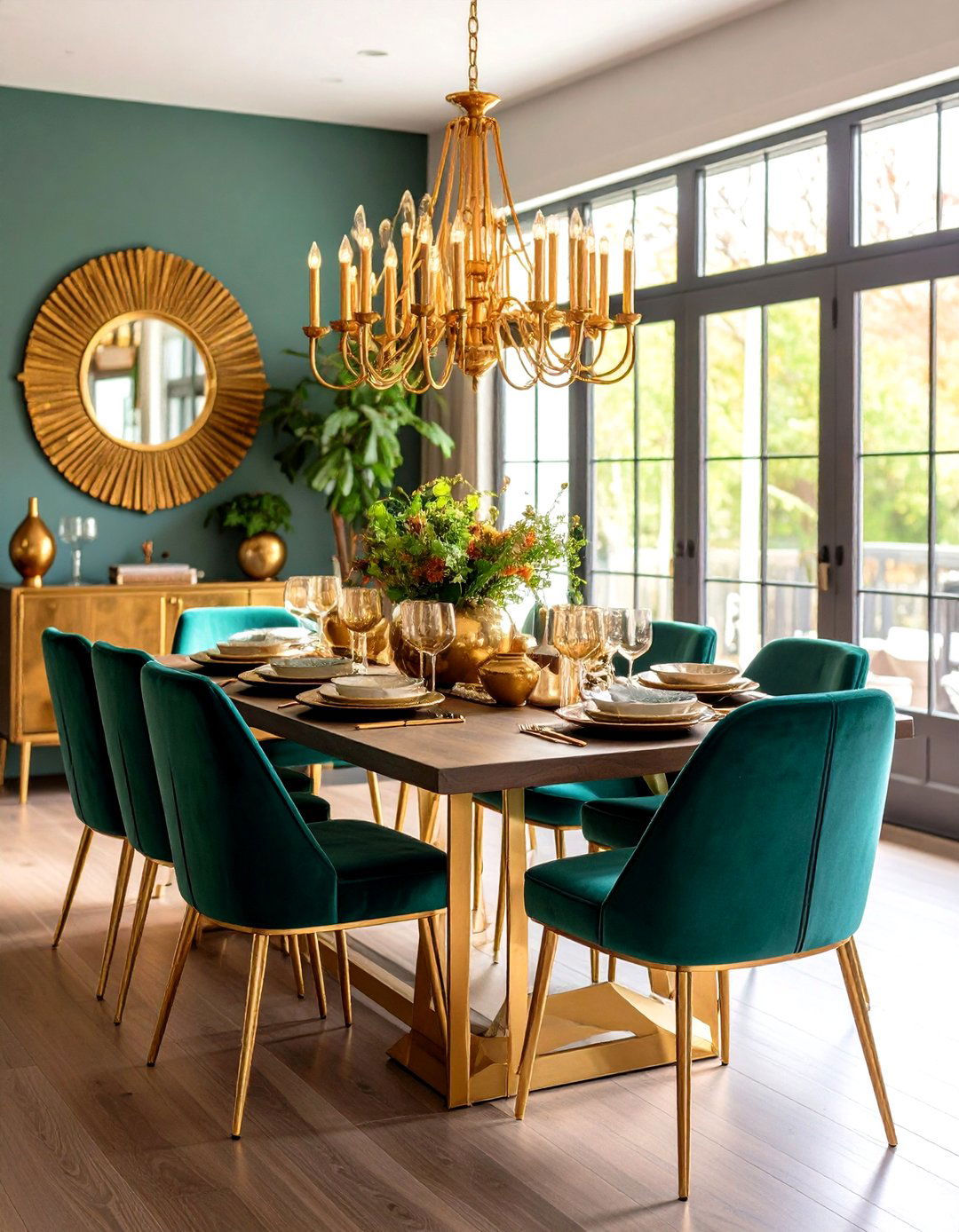
Gold and brass accents create stunning focal points that complement both traditional architecture and modern furnishings while adding warmth and elegance. Incorporate warm metallic finishes through lighting fixtures, cabinet hardware, serving pieces, and decorative accessories that catch and reflect light beautifully. Antique burnished brass frames paired with crystal or cut glass elements cast gorgeous shimmer around rooms for real-life beauty filter effects. Choose pieces that vary in scale and placement to create visual interest without overwhelming the space - perhaps brass chandelier arms, copper serving bowls, or gold-framed mirrors. These metallic elements bridge traditional elegance with contemporary sophistication while adding layers of visual texture that enhance the overall design complexity.
14. Transitional Dining Room Seasonal Decorating Flexibility
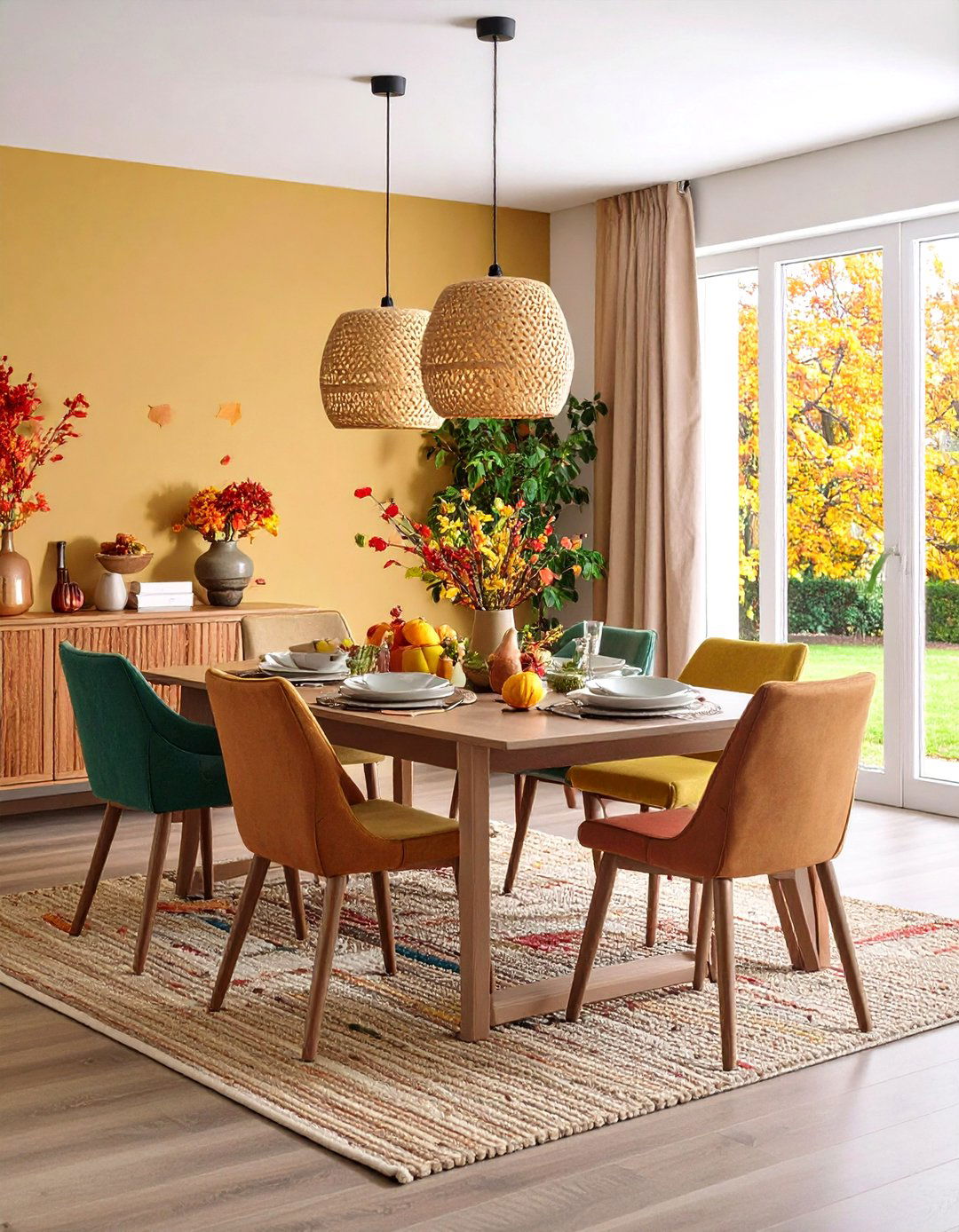
Design your transitional dining room with seasonal adaptability in mind, creating a foundation that easily accommodates changing decorative accents throughout the year. Artwork can be swapped year-round to accommodate seasonal trends, with neutral foundations allowing flexibility in decorative choices. Invest in quality foundational pieces - furniture, lighting, and area rugs - in neutral colors that provide timeless backdrops for seasonal touches. Change table runners, centerpieces, throw pillows on dining bench seating, or swap artwork to reflect different seasons or holidays. Simple yet stylish centerpieces such as fresh flowers in vases or decorative bowls make great finishing touches. This approach keeps your dining space feeling fresh and current while maximizing your investment in core furniture pieces.
15. Comfortable Transitional Dining Room Seating Solutions

Comfort has become key in dining design, with hard wooden chairs giving way to softer upholstery featuring arms and padded seats that encourage relaxing, enjoyable evenings. Select seating that balances style with functionality, choosing pieces that invite lingering conversations over meals. Benches are comfy and on-trend additions to dining room setups, offering flexible seating that accommodates varying numbers of guests. Consider mixing upholstered chairs at table ends with sleek bench seating along one side, or choose dining chairs with subtle traditional details like nailhead trim combined with contemporary proportions. Fabrics like cotton, leather, wool, velvet, and linen work better than trendy bouclé textures for lasting transitional appeal. Quality, comfortable seating ensures your transitional dining room becomes a favorite gathering place.
16. Balanced Transitional Dining Room Proportions and Scale

Proportions are crucial in transitional spaces, ensuring that different finishes and pieces complement each other regardless of the era they come from. Apply thoughtful consideration to furniture scale, ensuring your dining table size suits the room dimensions while leaving adequate circulation space. Leave 42-48 inches between your table and walls so diners can sit down and get up easily from their chairs. Apply the 60:40 rule where traditional style is slightly more prevalent and modern elements act as accents, working with the inherent qualities of different furniture styles. Balance larger traditional pieces with smaller, lighter contemporary elements to create harmonious compositions. Consider ceiling height when selecting chandelier size and artwork scale to maintain pleasing proportions throughout the space.
17. Transitional Dining Room Multi-Functional Design Solutions
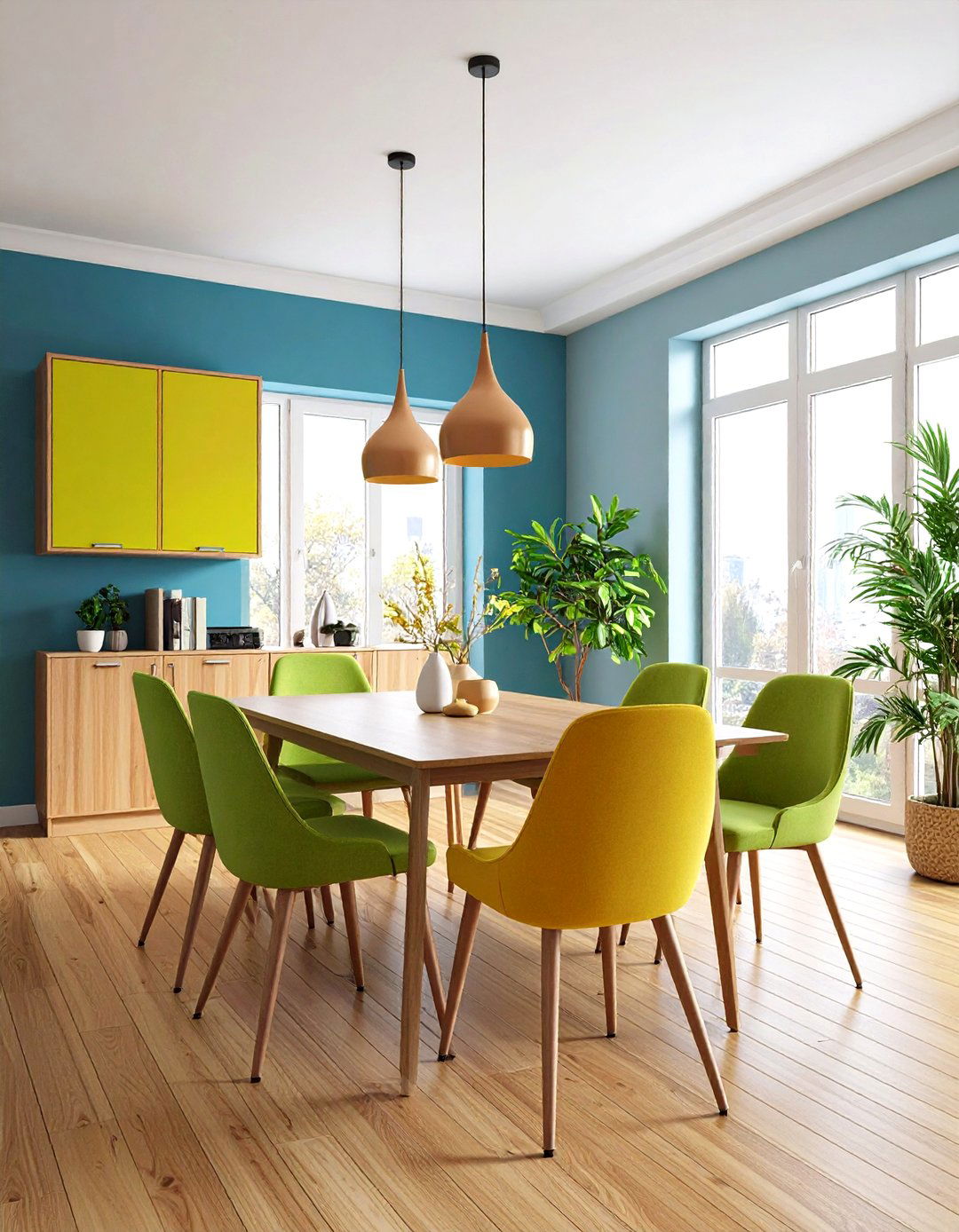
People are thinking about dining rooms in new ways, with many requesting multi-function spaces that serve as home offices as well as formal dining areas. Design your transitional dining room to accommodate various activities beyond meals by incorporating versatile furniture and storage solutions. Choose dining tables that work equally well for family dinners and homework sessions, with nearby storage for office supplies, games, or craft materials. Adjustable lighting that works for both evenings and work-from-home days, along with practical, ergonomic seating, keeps dining rooms relevant and versatile. Consider adding a nearby console or hutch that can store both dining accessories and work materials, ensuring your space adapts to your family's changing needs while maintaining its sophisticated aesthetic.
18. Textural Transitional Dining Room Fabric and Material Mixing
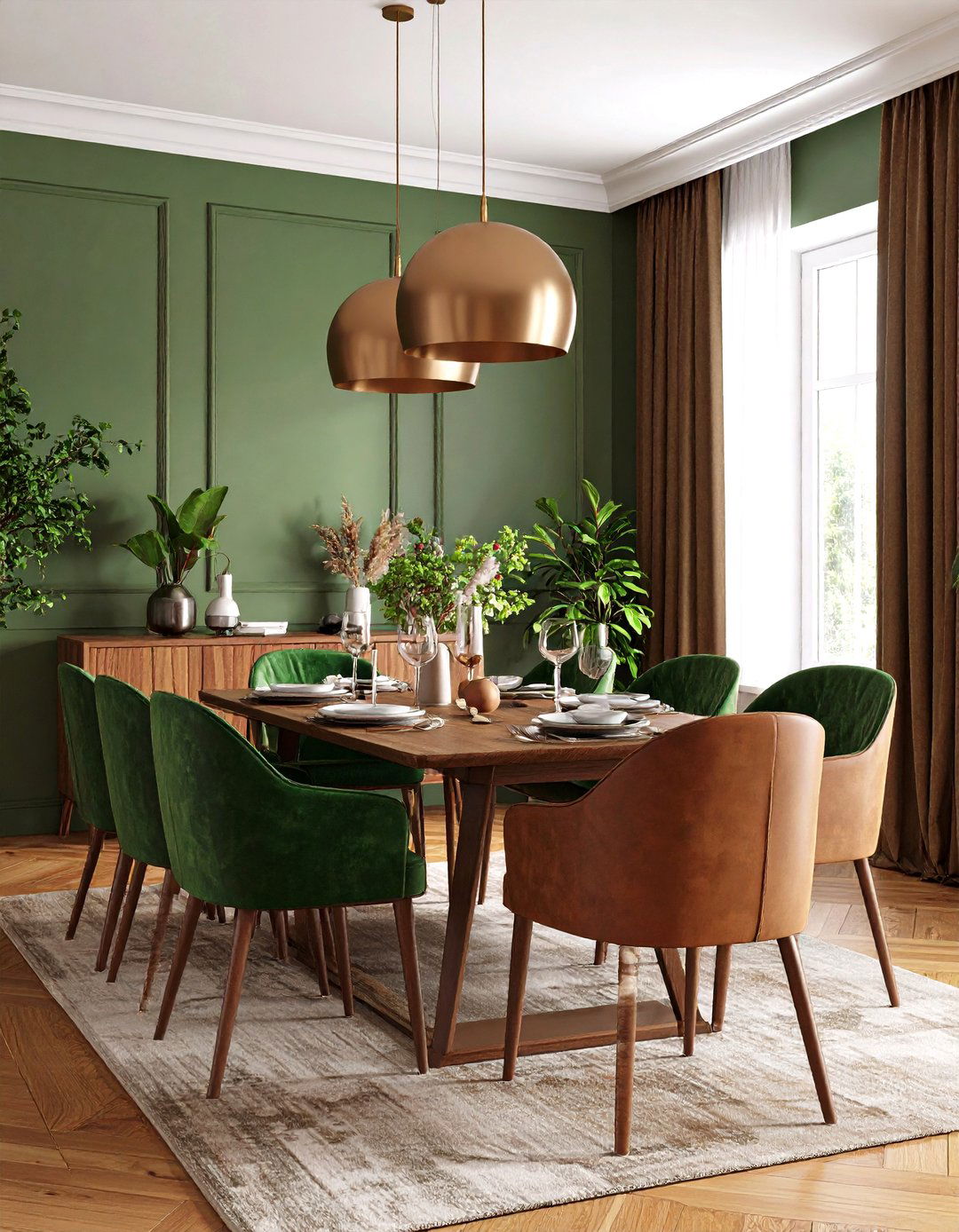
One hallmark of transitional chandeliers is mixing materials, and this principle extends throughout transitional dining room design for extremely versatile, harmonious results. Combine different textures thoughtfully through upholstery choices, window treatments, table linens, and decorative accessories. Layering textures like velvet, leather, and aged woods elevates spaces while creating luxurious, cozy ambiance. Mix smooth surfaces like polished wood tables with textured elements such as nubby linen chair cushions, woven placemats, or carved wooden serving pieces. Consider nailhead trim as a popular way to infuse traditional touches into contemporary furniture pieces. This layered approach creates visual depth and tactile interest while maintaining the balanced sophistication that defines successful transitional design.
19. Transitional Dining Room Built-In Storage and Display Features
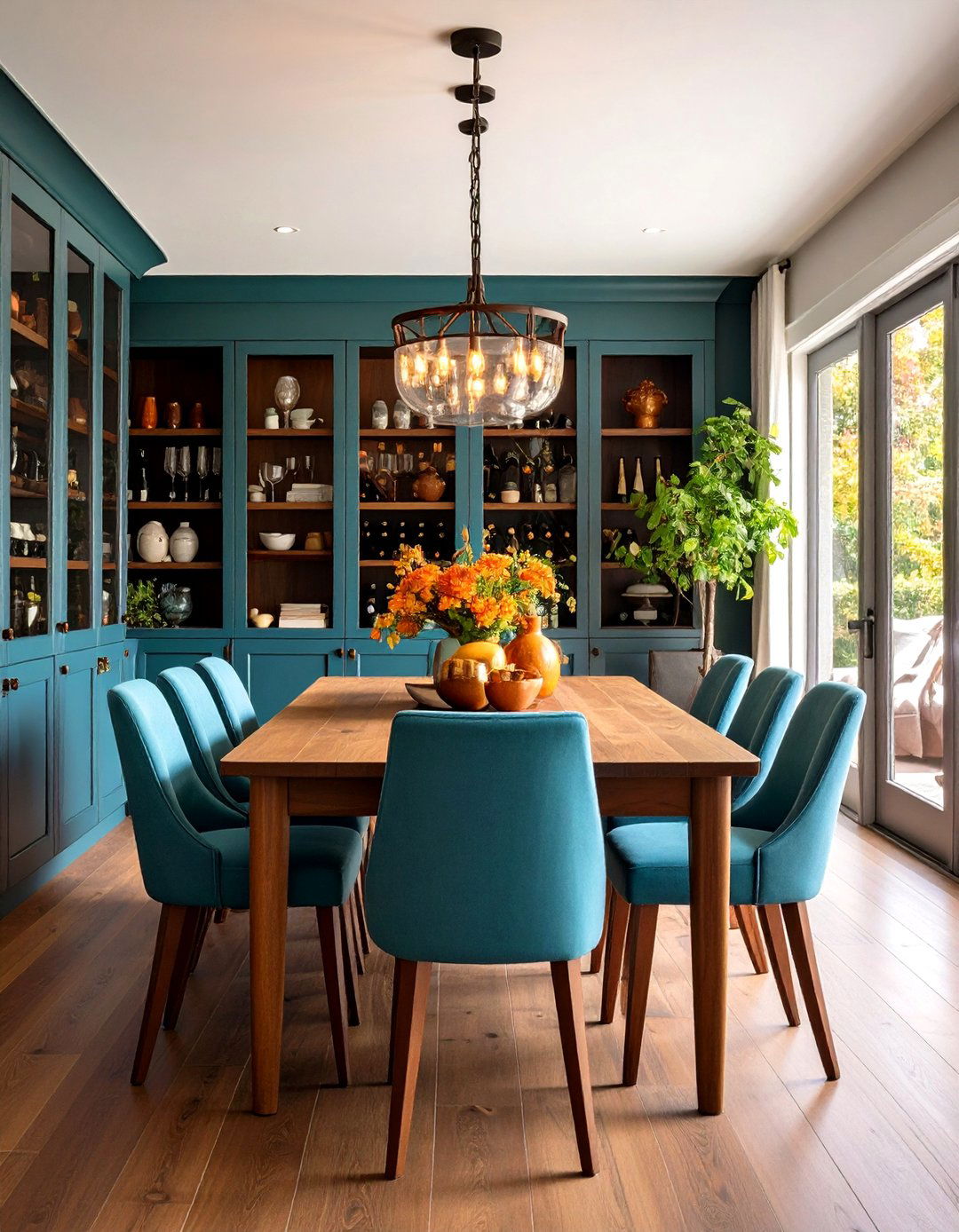
Clients are requesting wine walls, built-in bars, and curated bar carts, transforming rarely used rooms into stylish entertaining destinations. Consider incorporating custom built-in features that serve both storage and display purposes while maintaining clean, streamlined aesthetics. Built-in china cabinets with glass fronts showcase beautiful dinnerware while keeping pieces dust-free and organized. Choose pieces with both closed storage and open shelving to display favorite dishes or decorative items. Corner hutches maximize space efficiency while adding architectural interest, and built-in window seats with storage underneath provide extra seating and organization. These permanent features add significant value to your home while creating the custom, collected-over-time feeling that transitional design celebrates.
20. Transitional Dining Room Lighting Control and Ambiance Creation
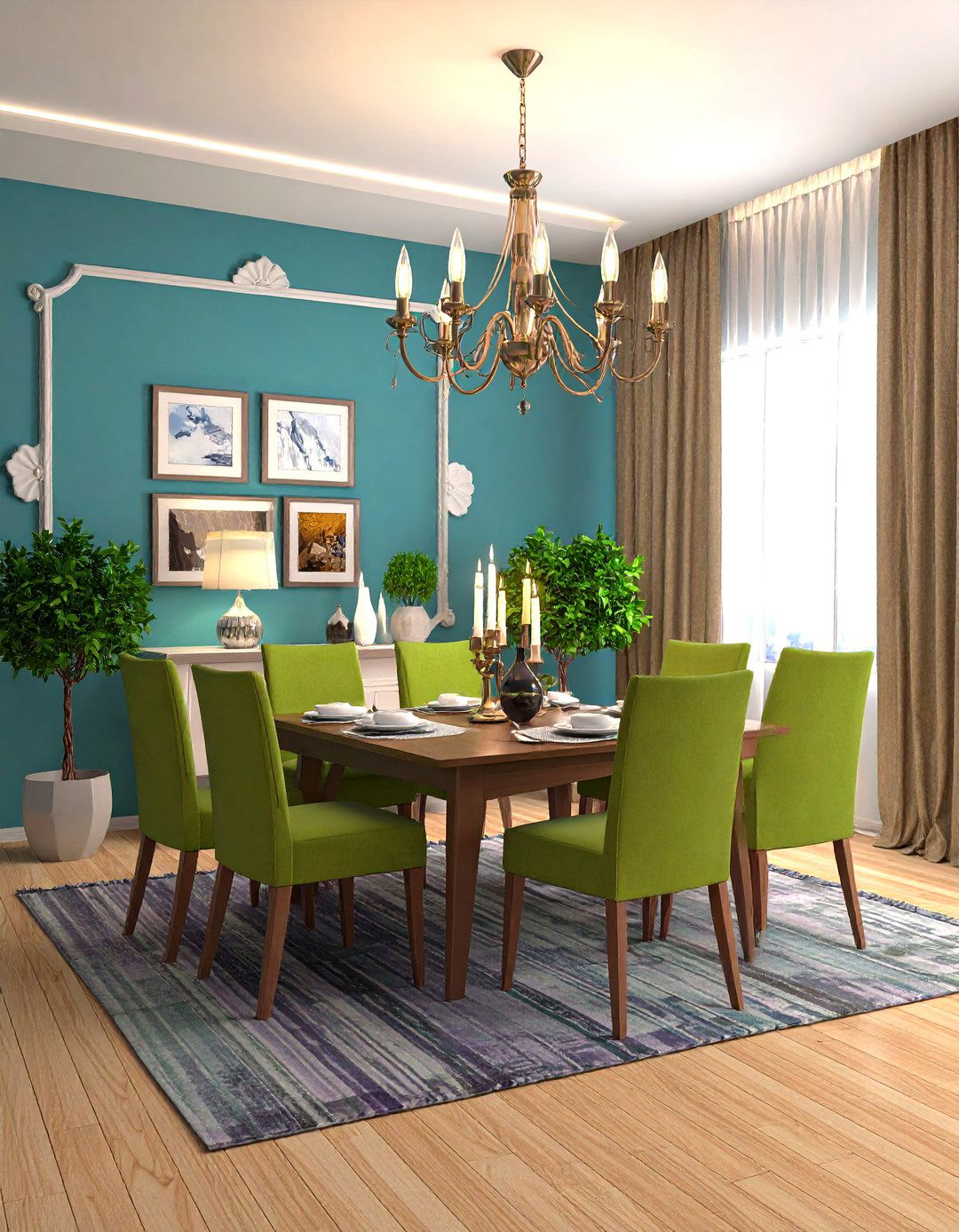
Battery-operated candles that look realistic are trending, with rooms lit to perfection and glowing with honey-hued candlelight taking over from heavy overhead chandeliers for dramatic effect. Install comprehensive lighting controls that allow you to create different moods for various occasions, from bright family meals to intimate dinner parties. Layer multiple light sources - overhead chandeliers, wall sconces, table lamps, and accent lighting - all controlled by dimmer switches for maximum flexibility. Adjustable lighting that works for both entertaining evenings and practical work-from-home days keeps dining rooms relevant and versatile. Consider smart lighting systems that allow preset scenes for different activities. Add candles or flameless alternatives for special occasions, creating warm, inviting atmospheres that make every meal feel special.
Conclusion:
Transitional dining rooms offer the perfect solution for homeowners seeking spaces that feel both timeless and current, sophisticated yet comfortable. When done right, mixing old and new achieves harmonizing, inviting effects that create truly timeless designs. By thoughtfully balancing traditional elements with contemporary touches, neutral foundations with personal accents, and formal elegance with everyday functionality, these versatile spaces adapt beautifully to your evolving lifestyle needs. The key lies in choosing quality, durable pieces that emphasize timeless elegance while incorporating flexible elements that allow for seasonal updates and personal expression. Whether you're hosting holiday celebrations or enjoying casual family dinners, your transitional dining room becomes a welcoming backdrop that enhances every gathering with its refined yet relaxed sophistication.


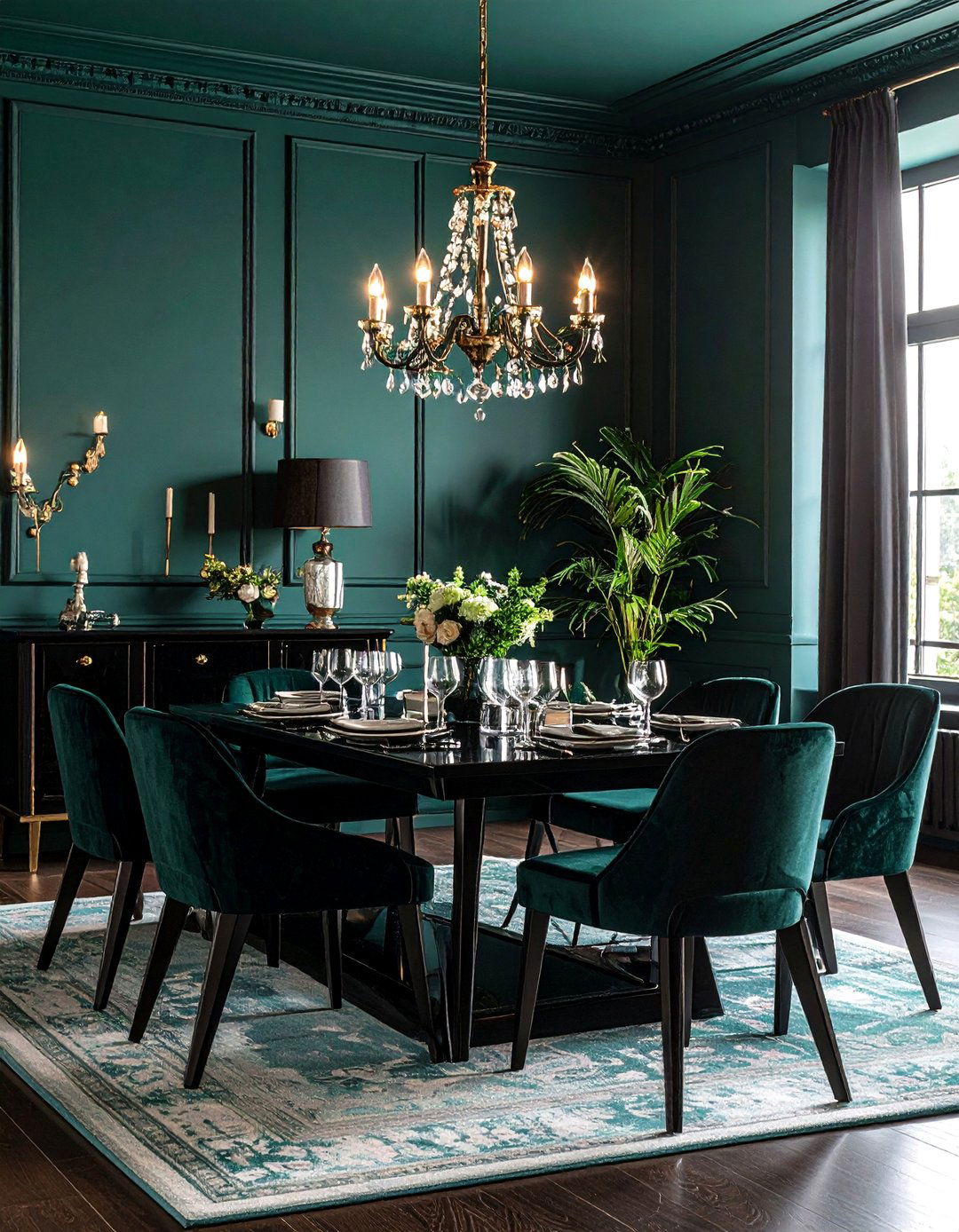
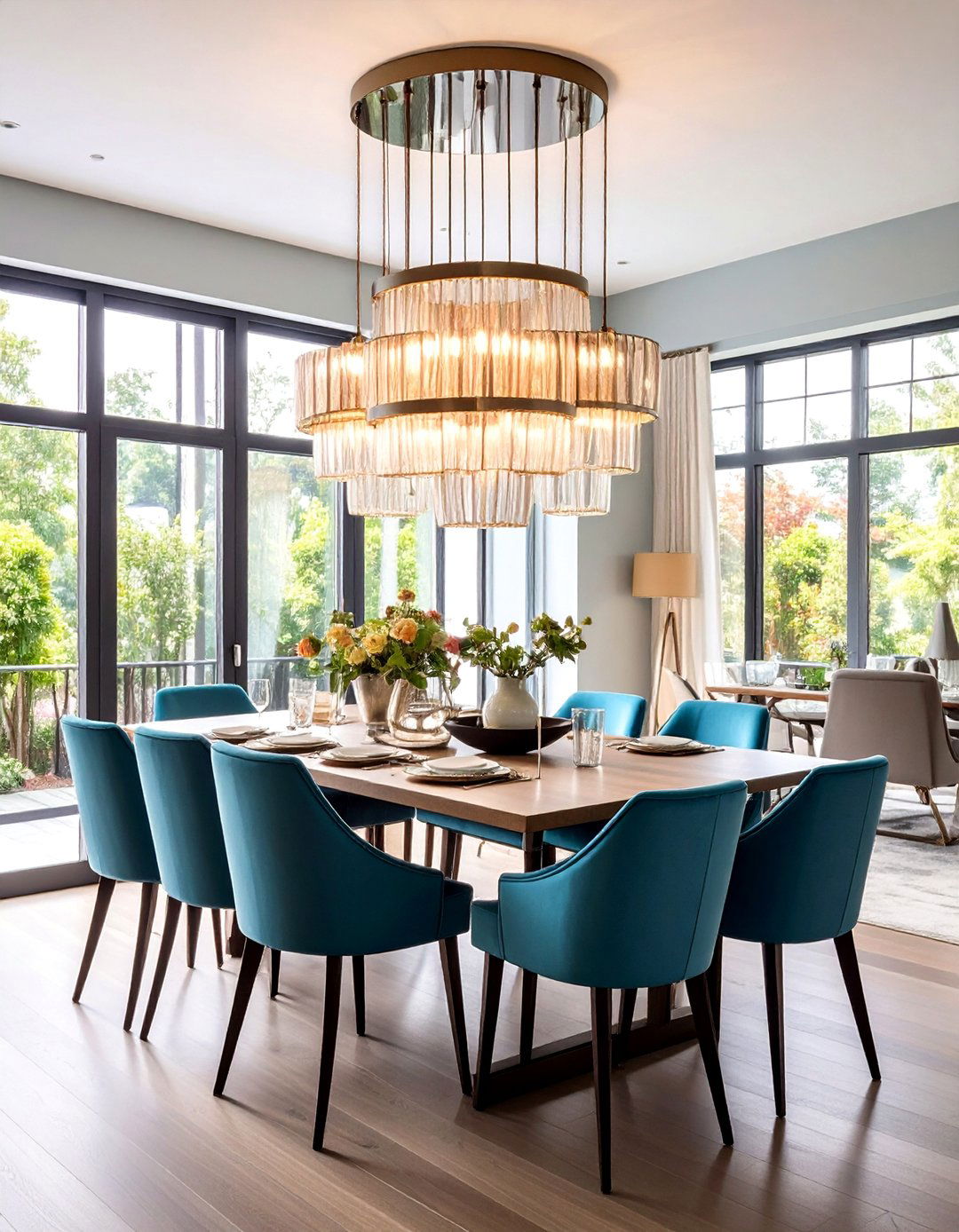
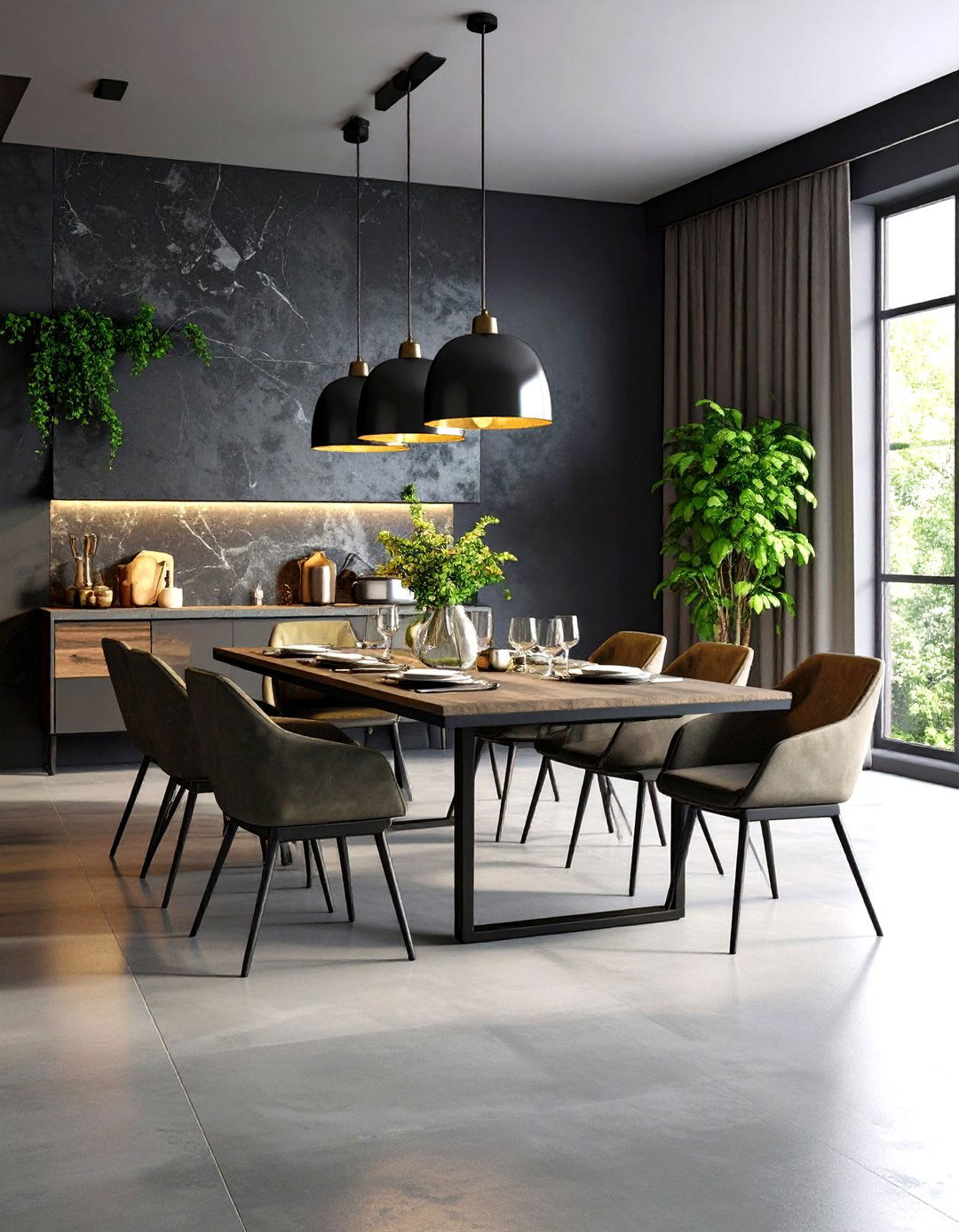


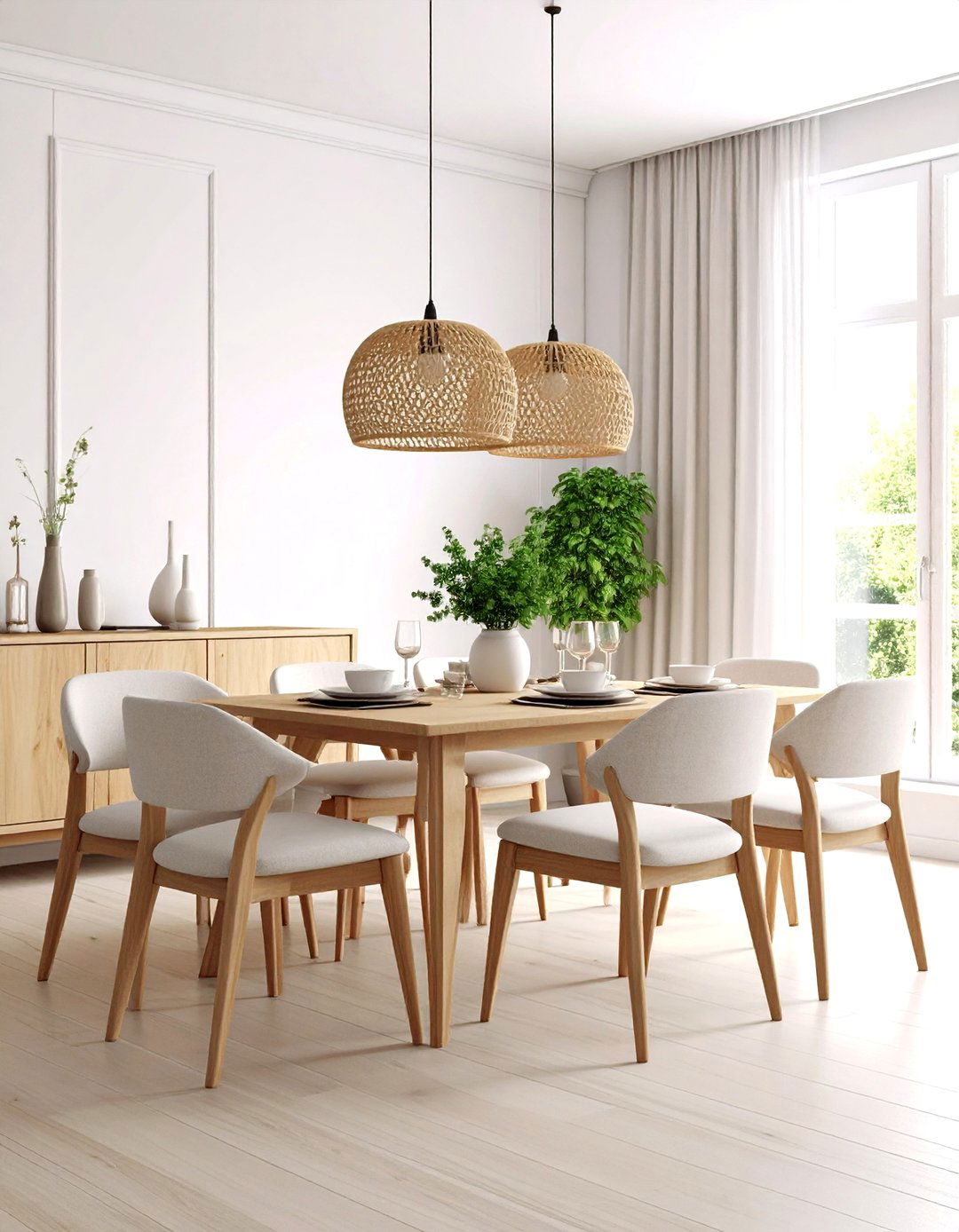
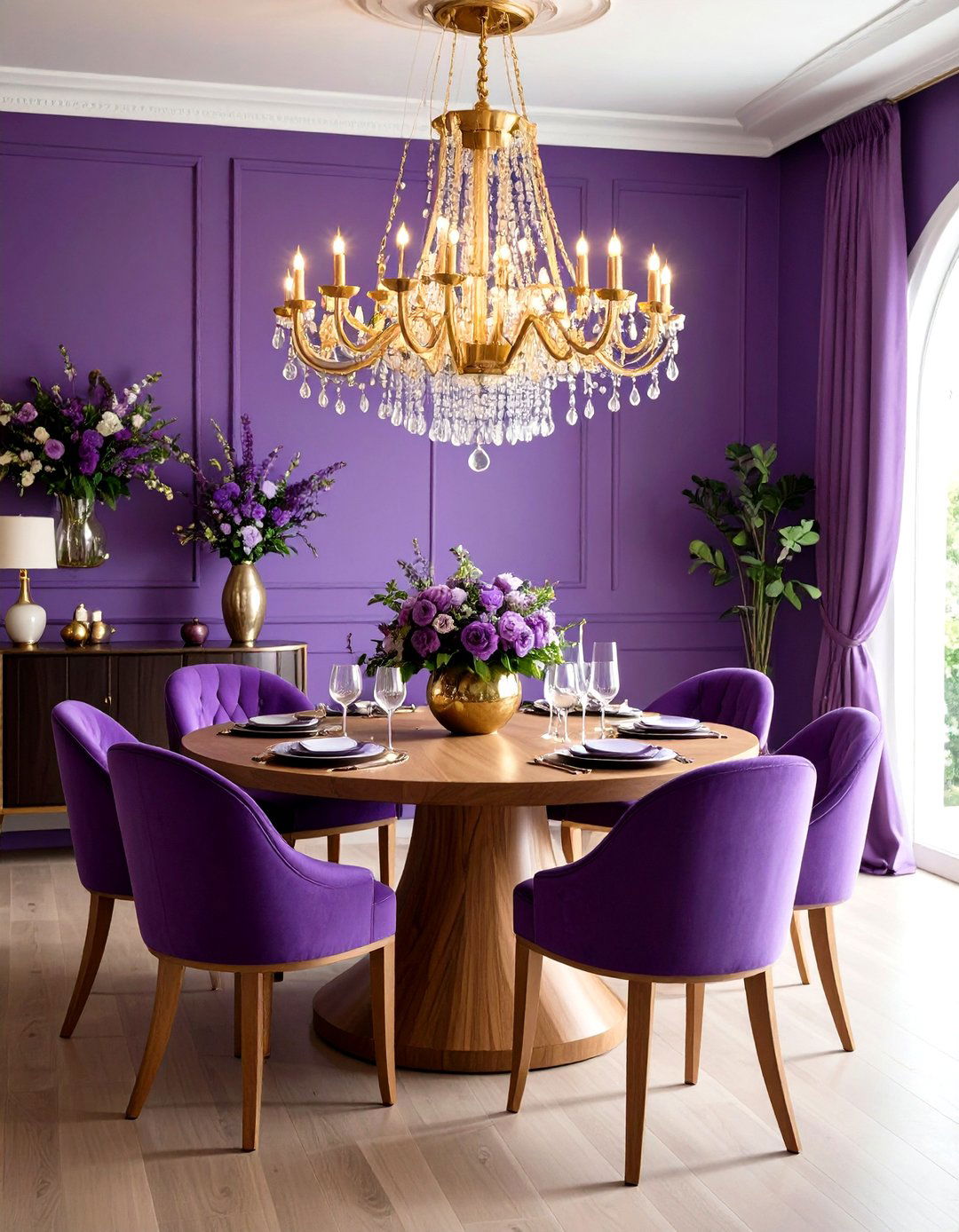
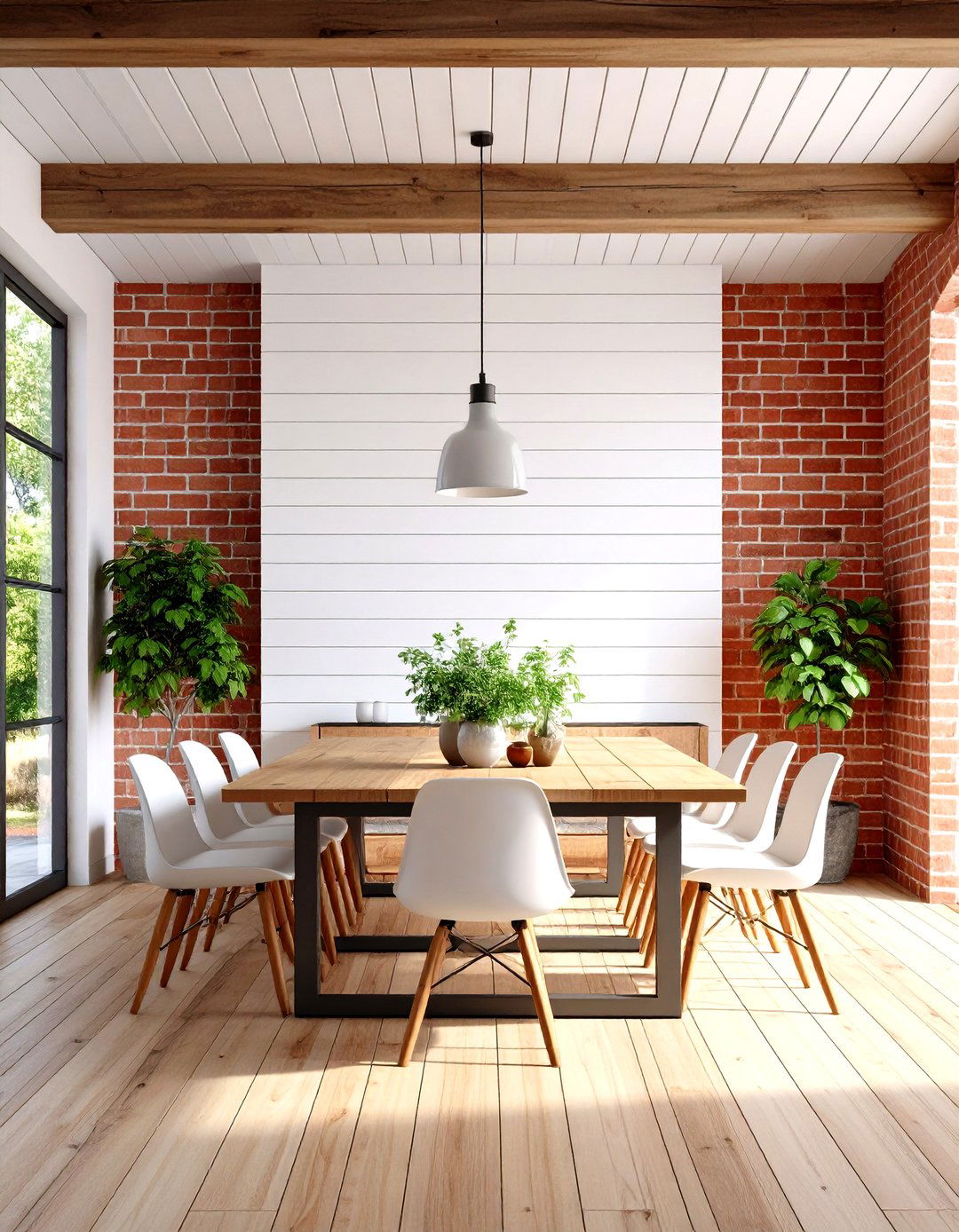
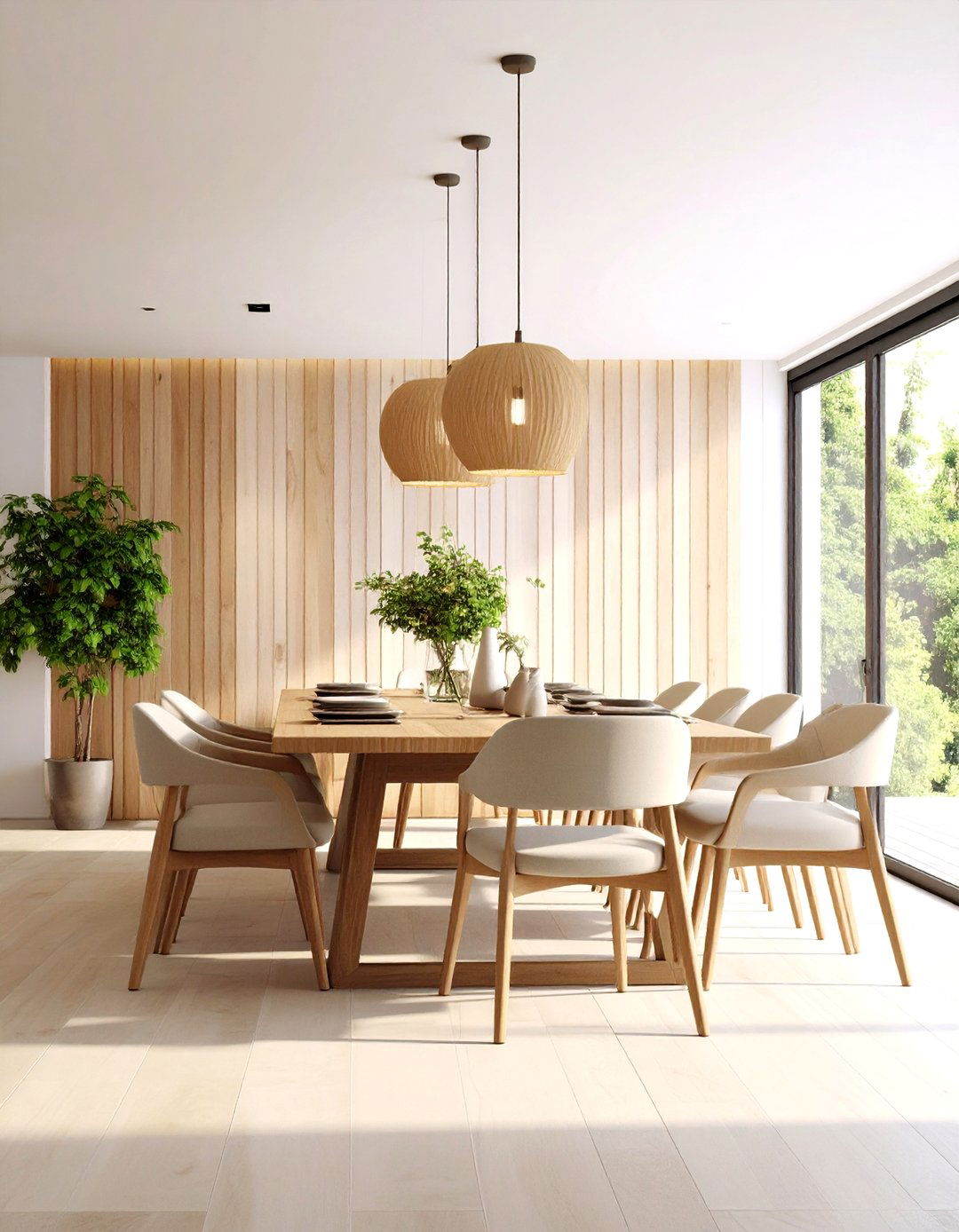
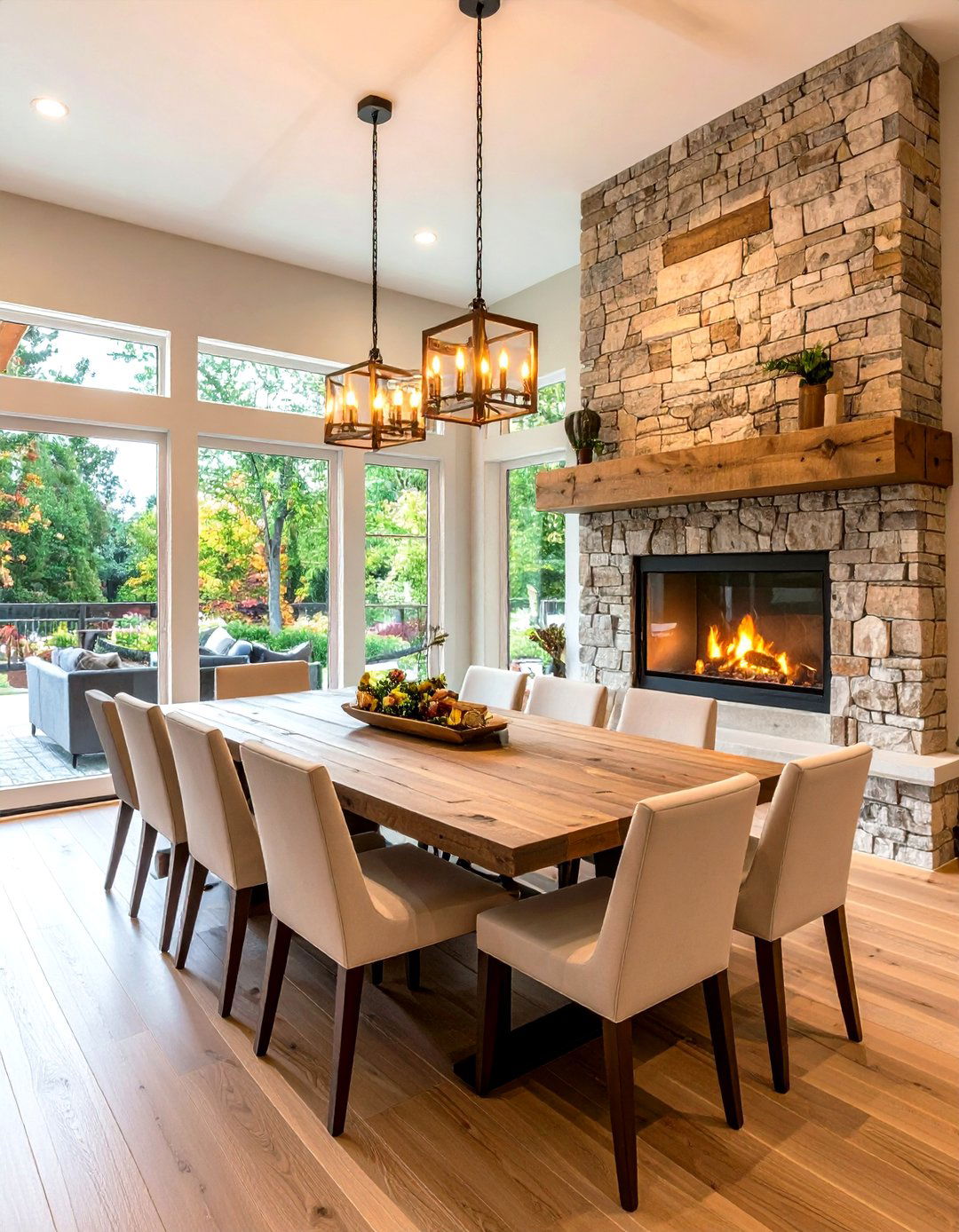

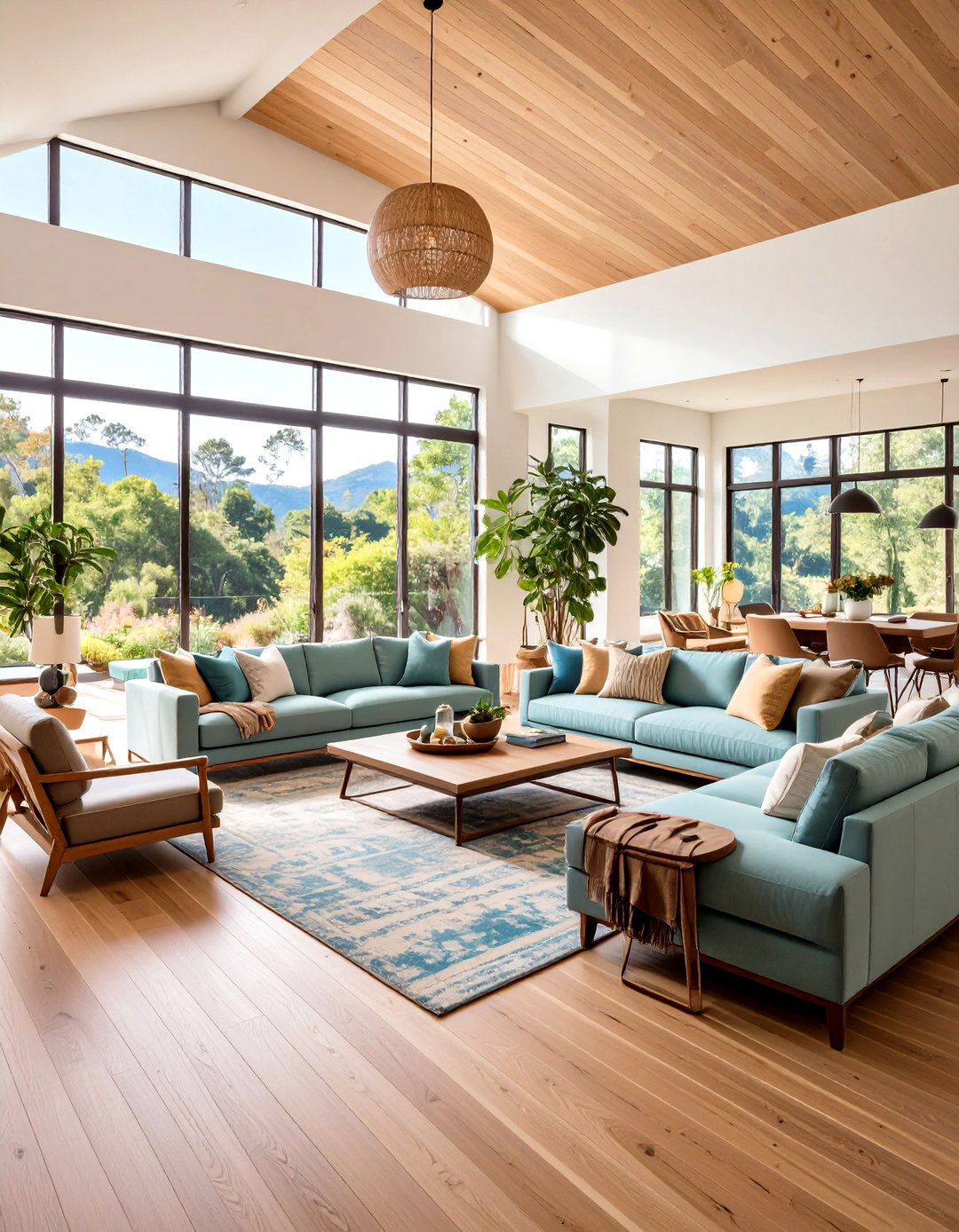

Leave a Reply